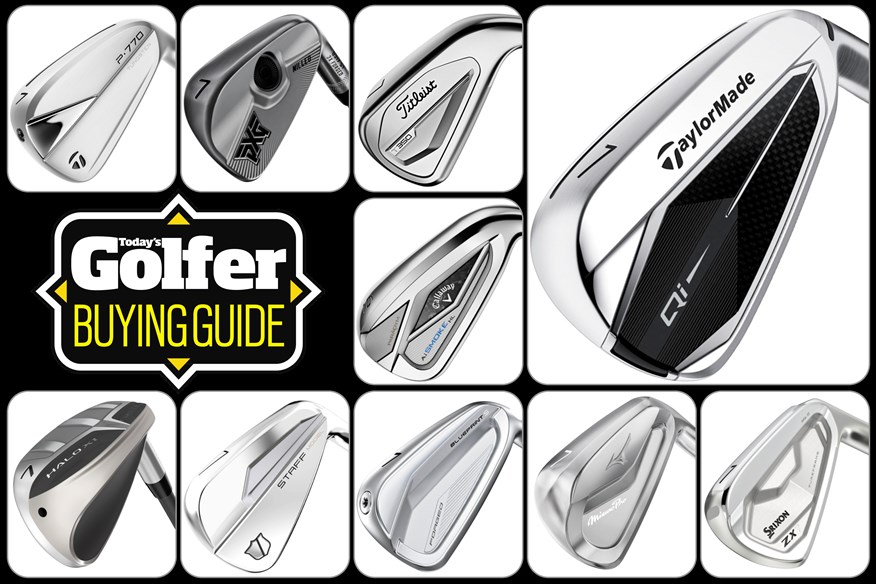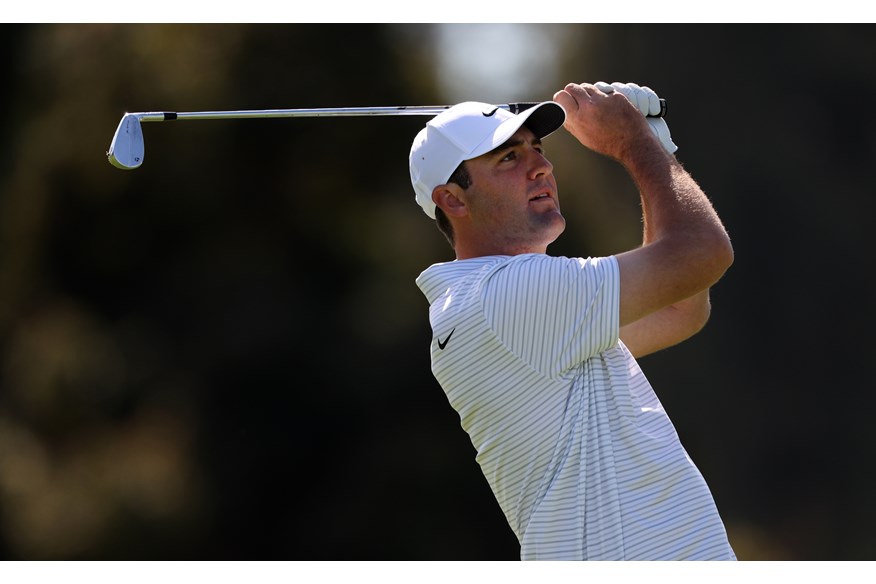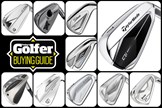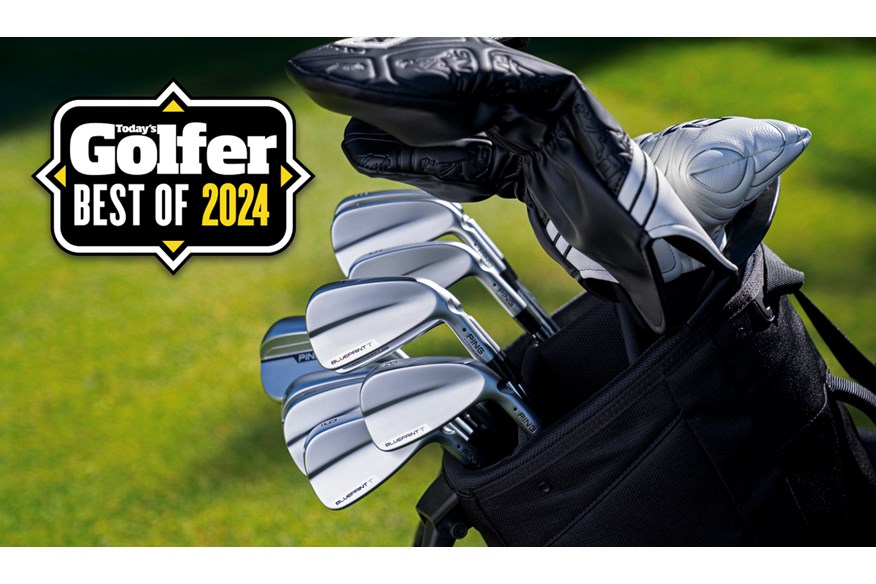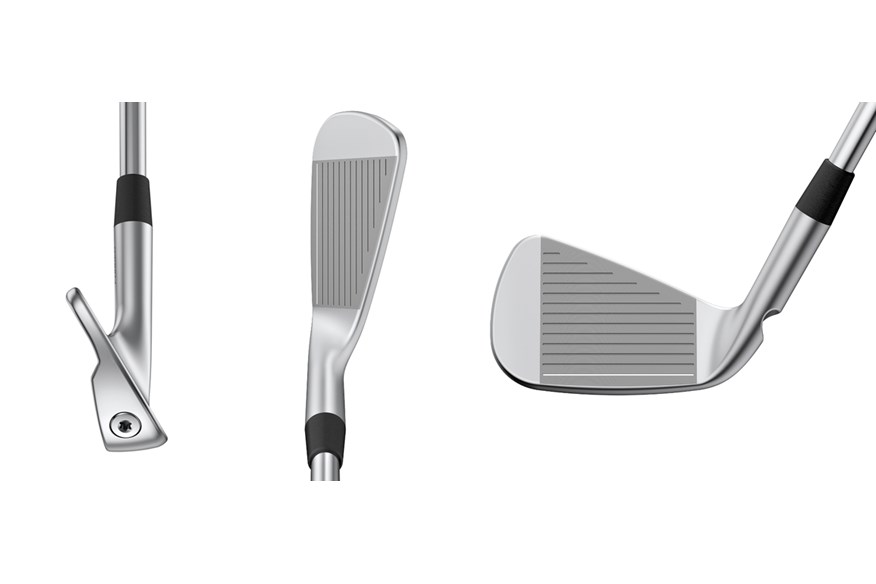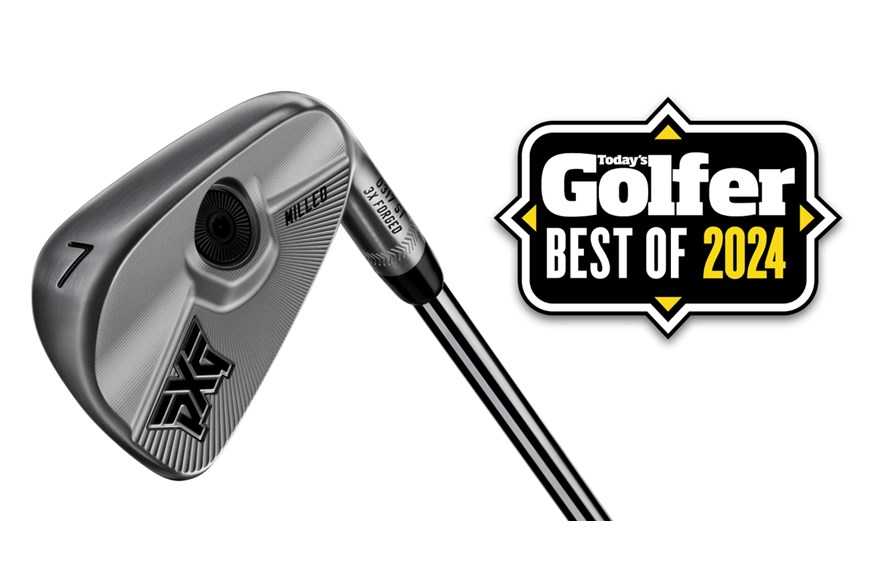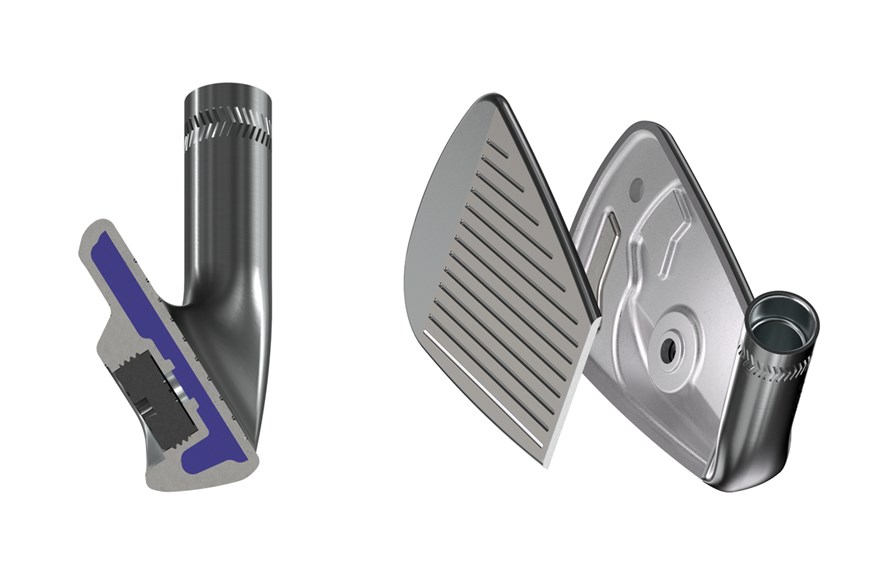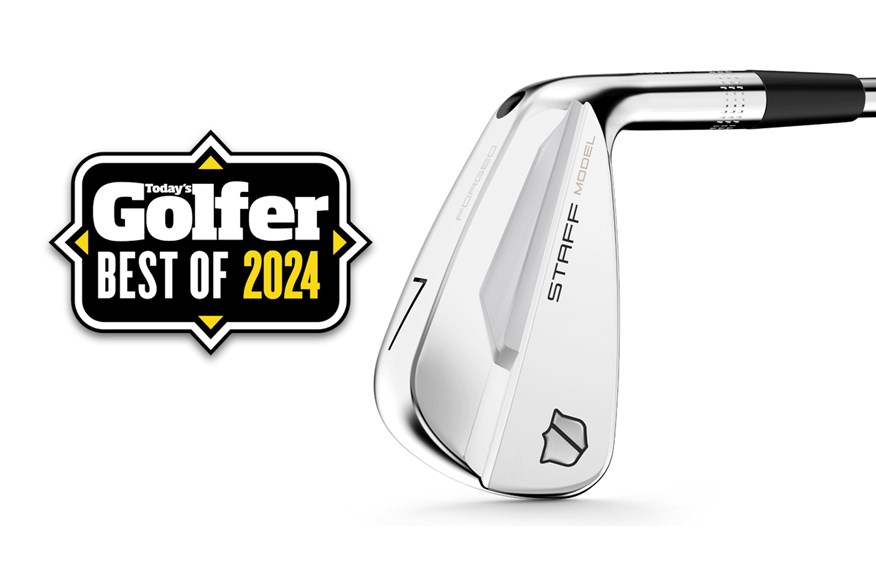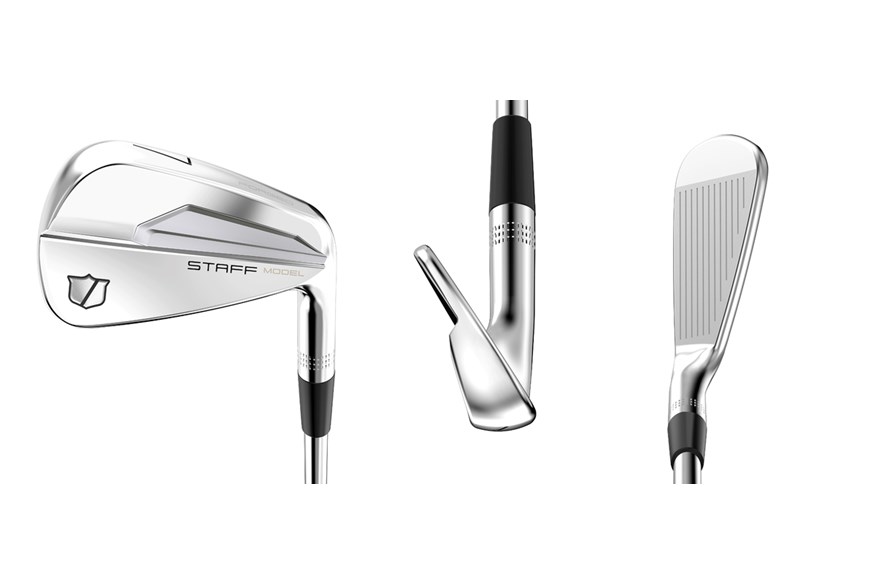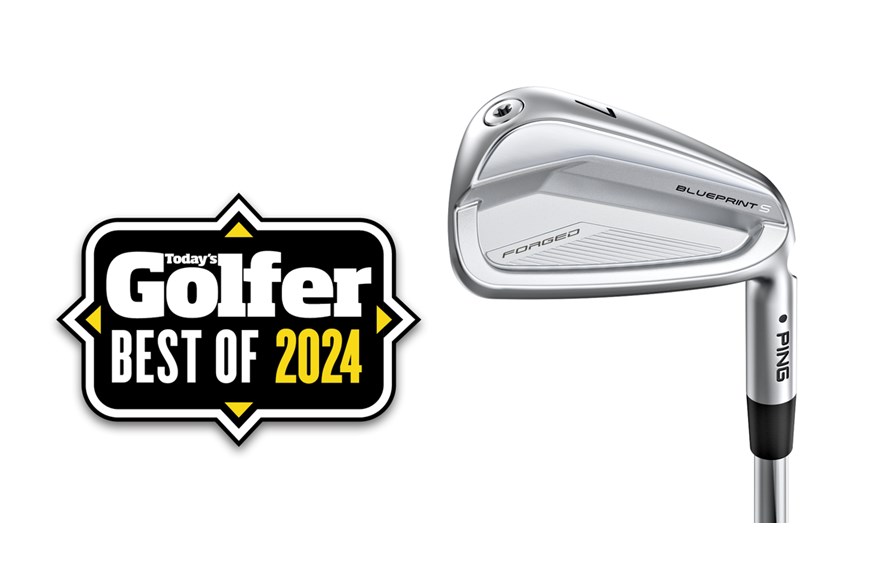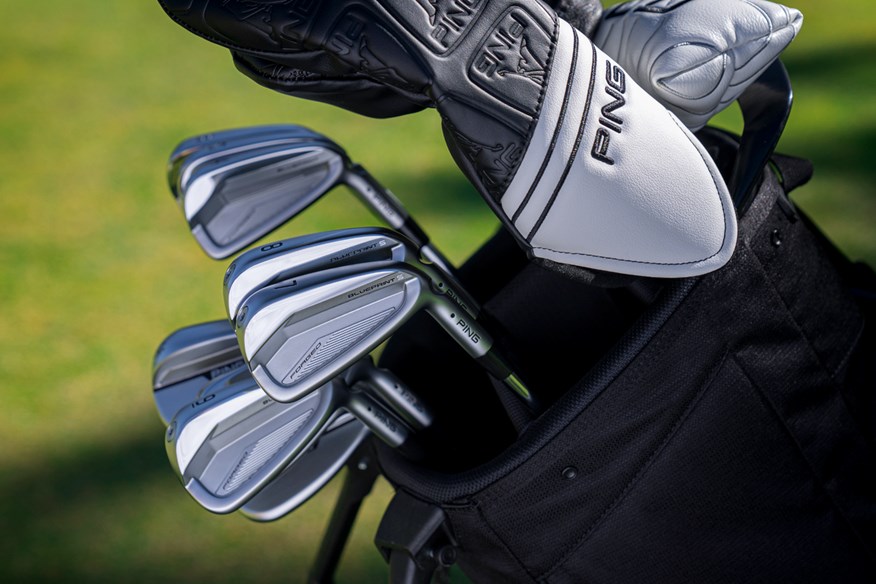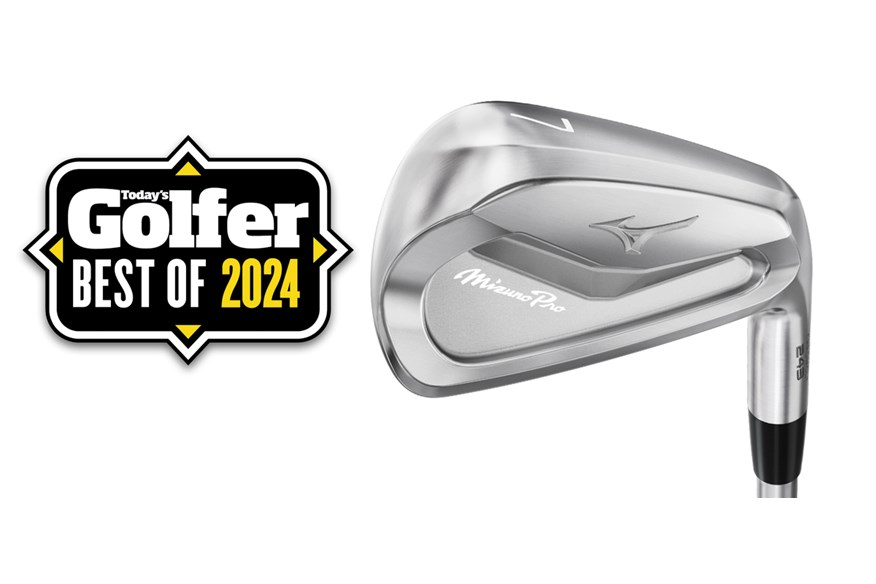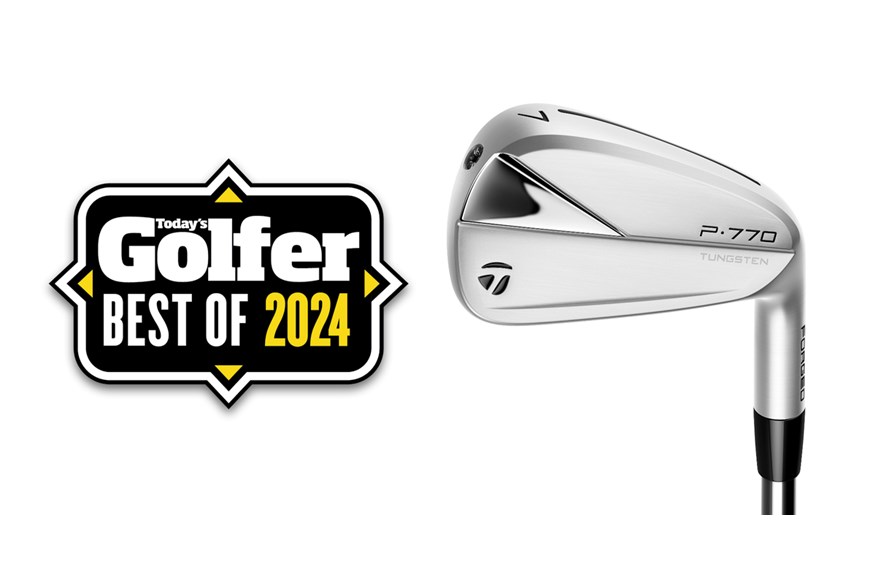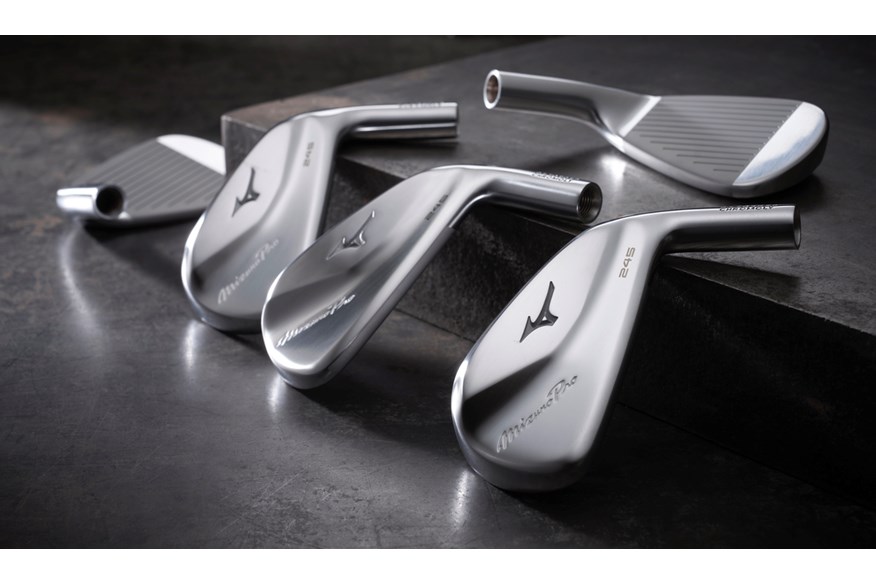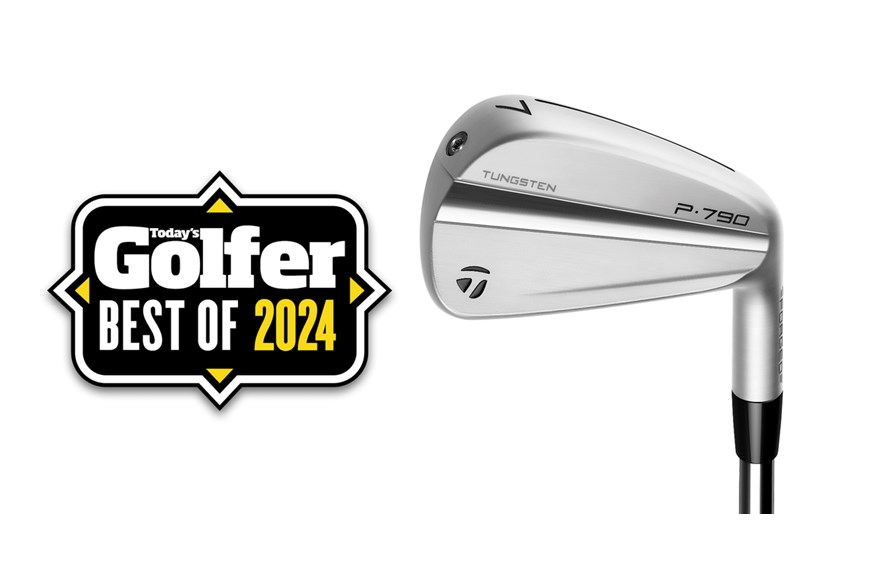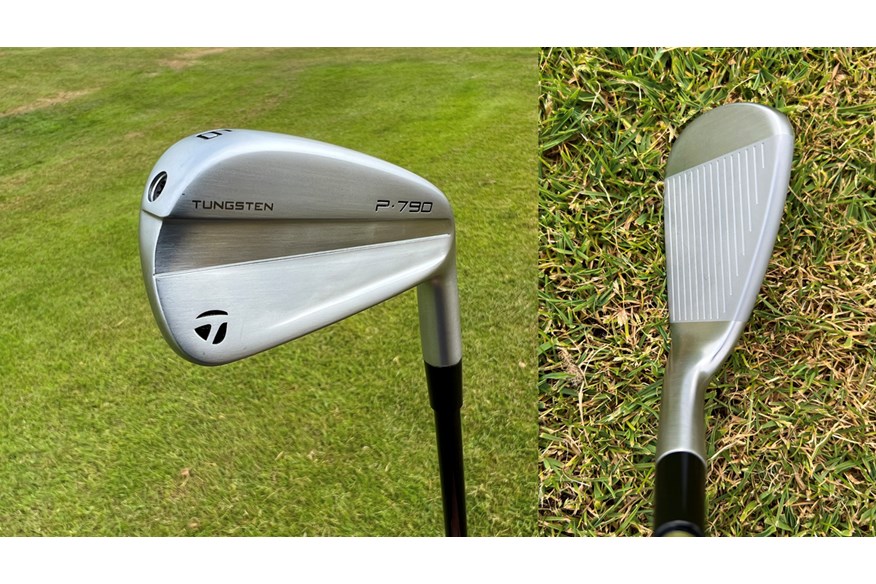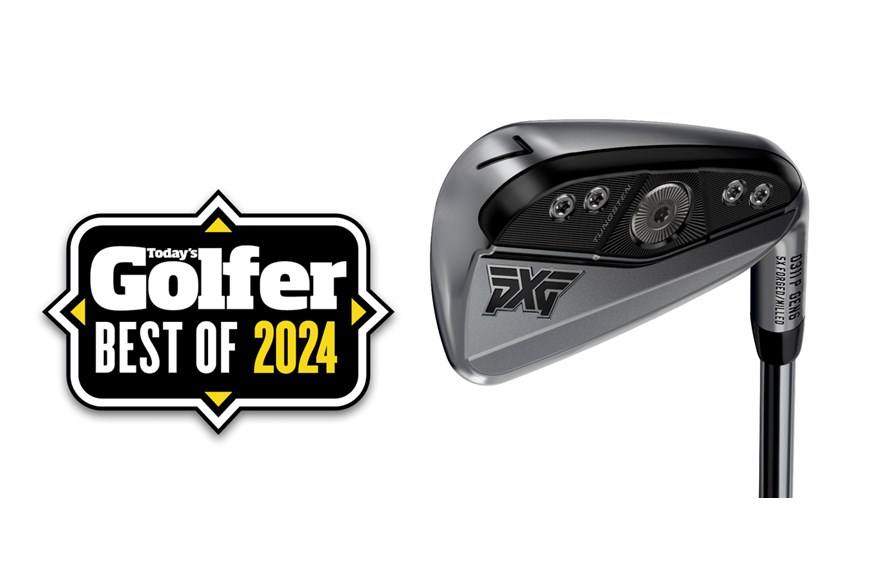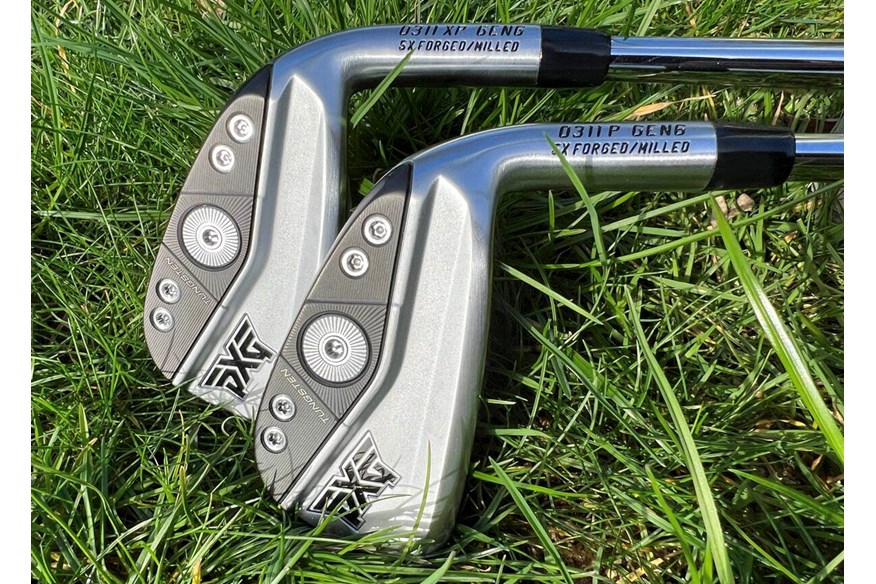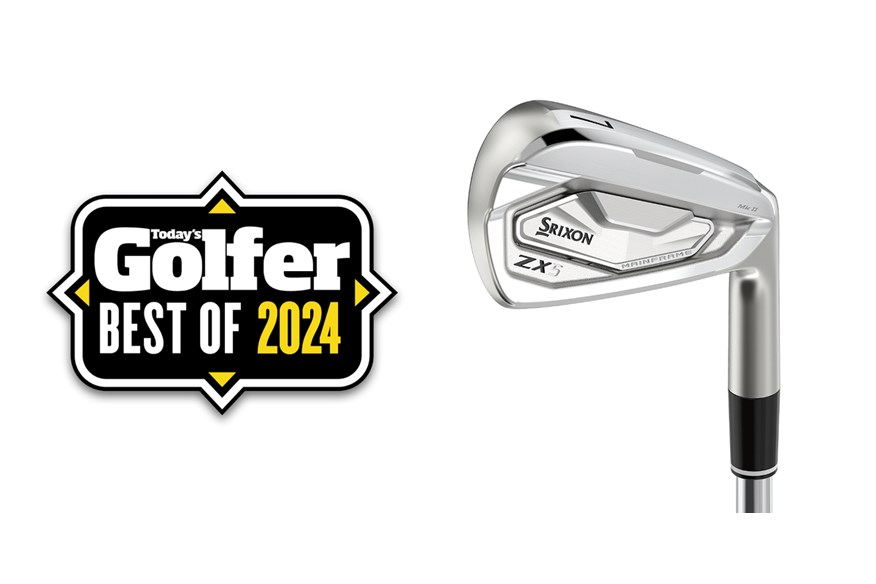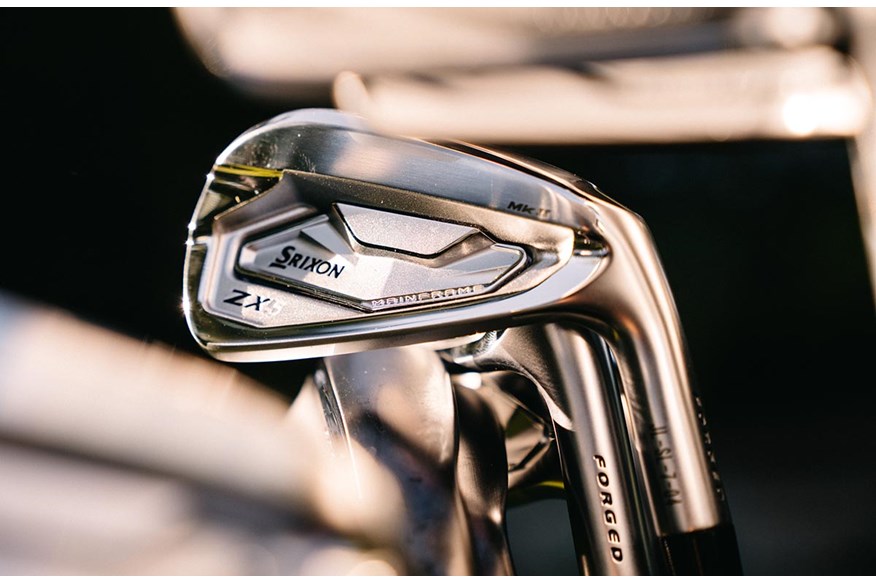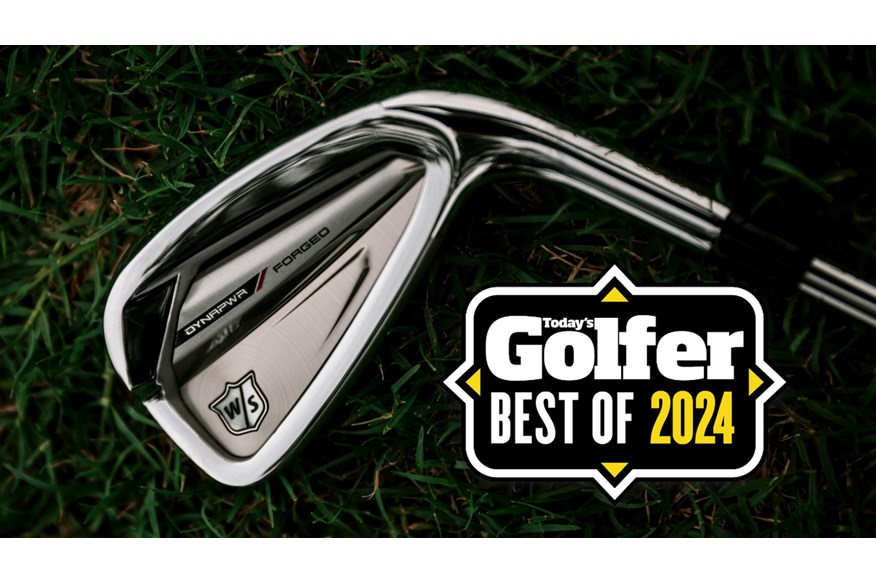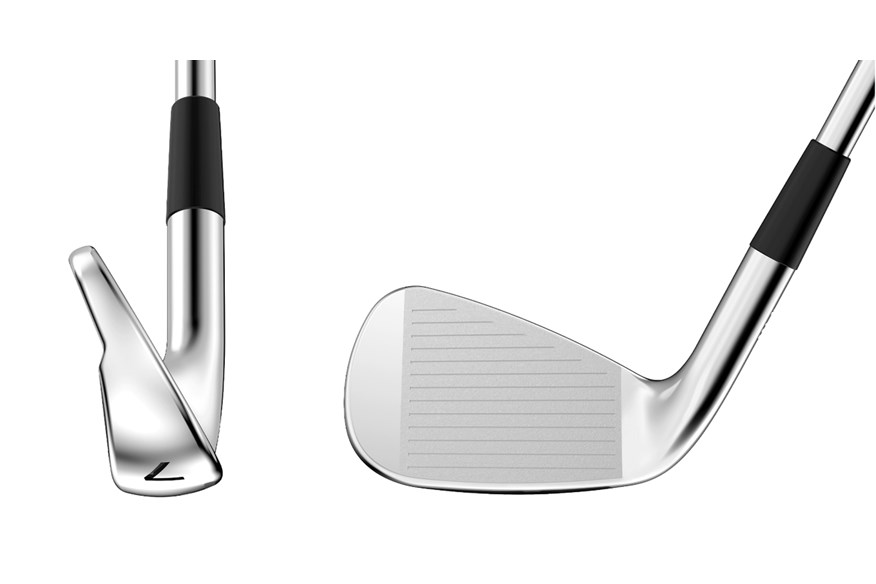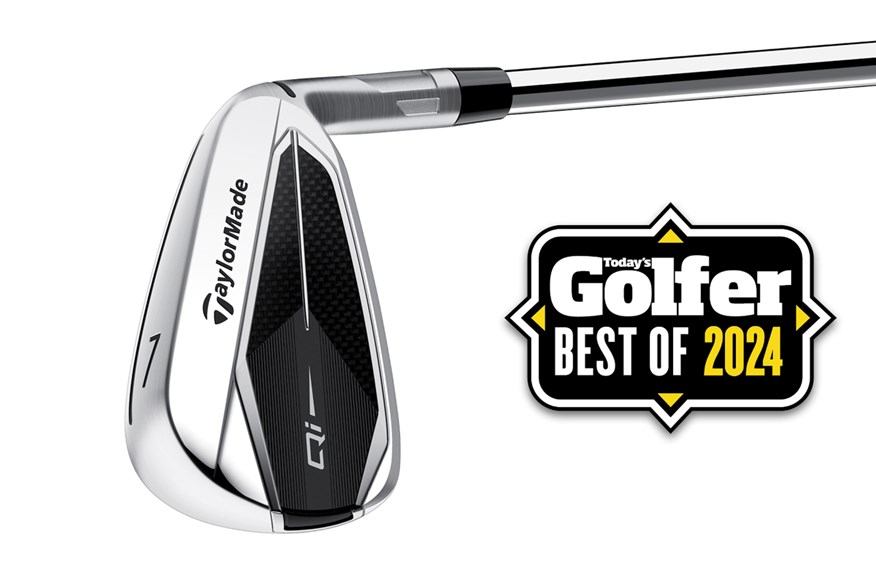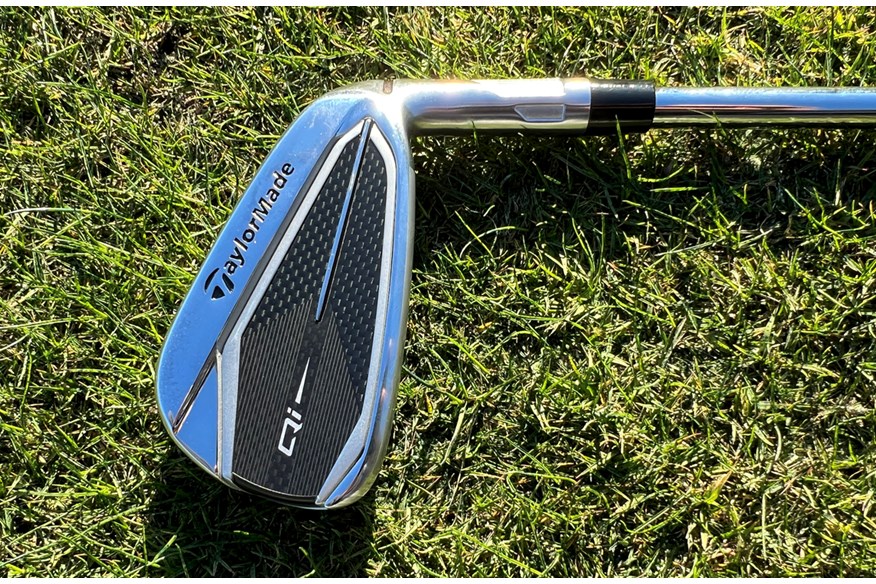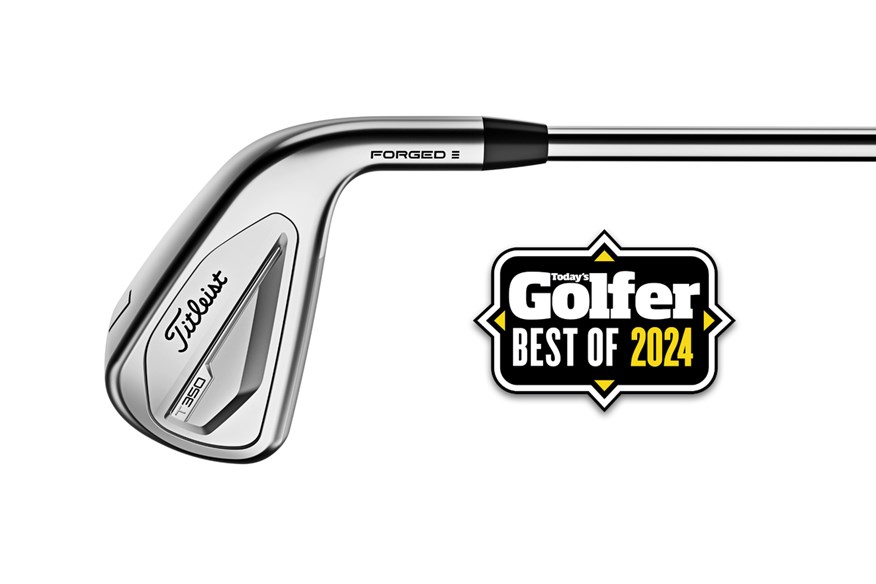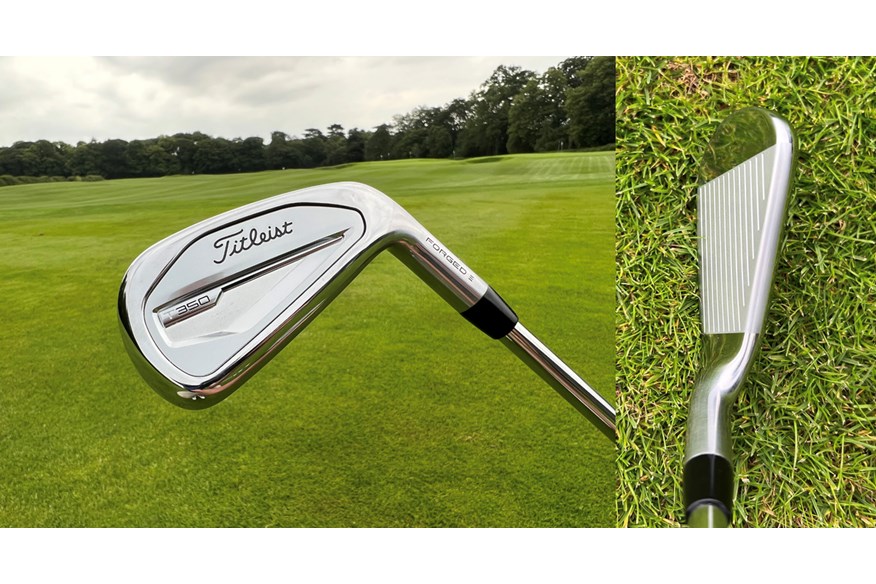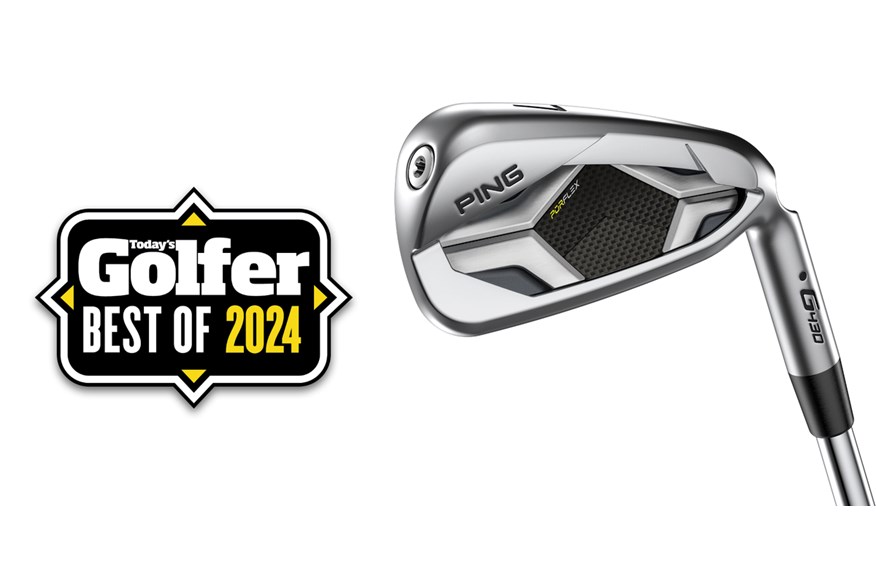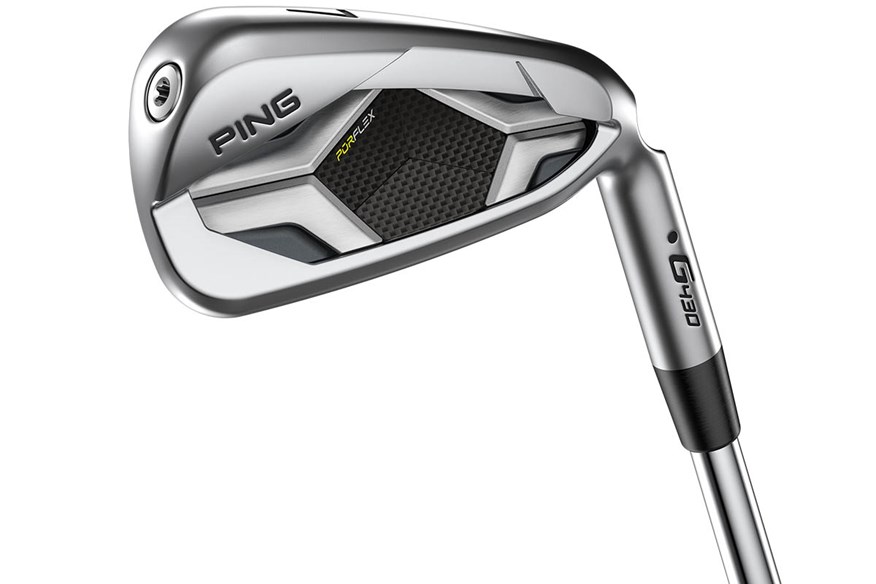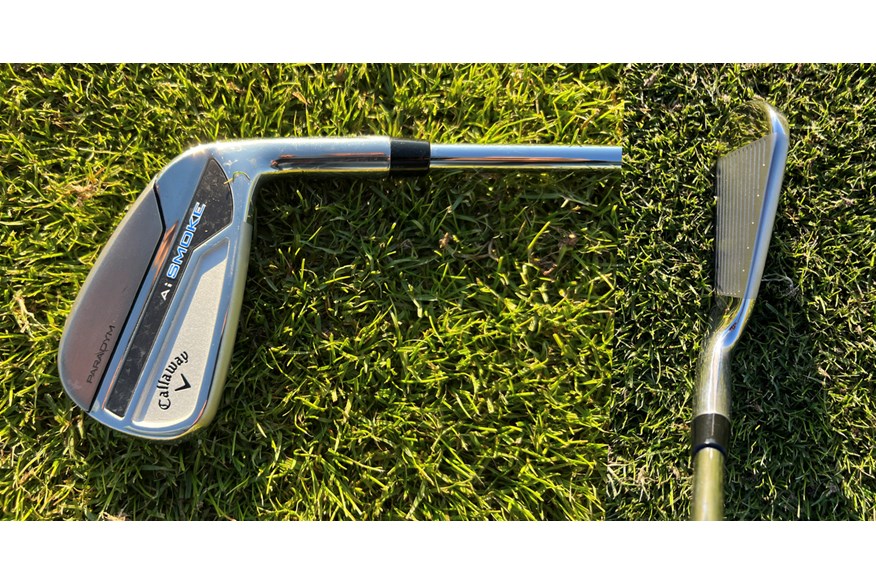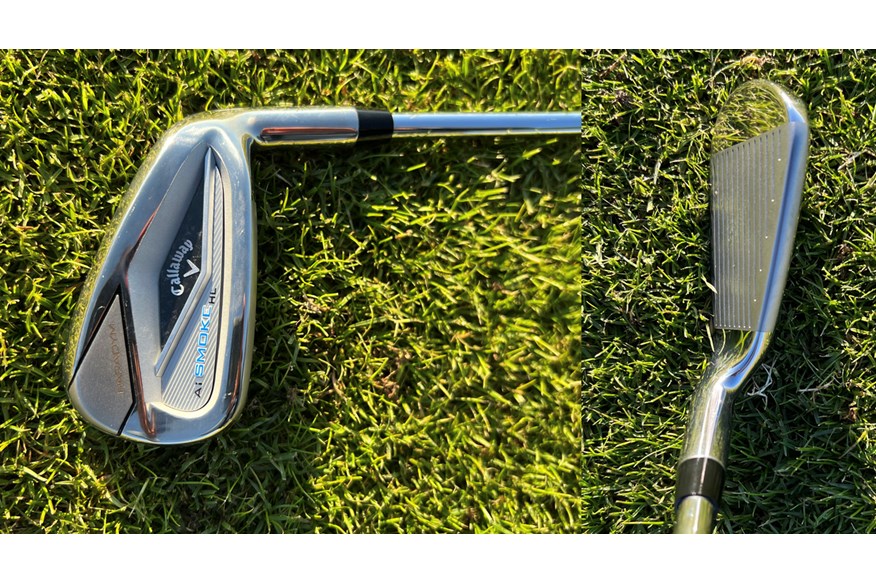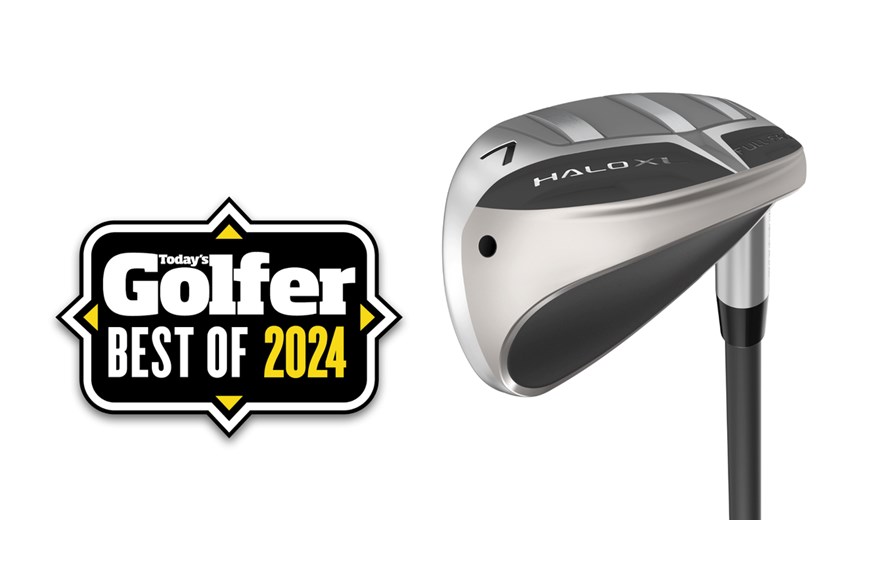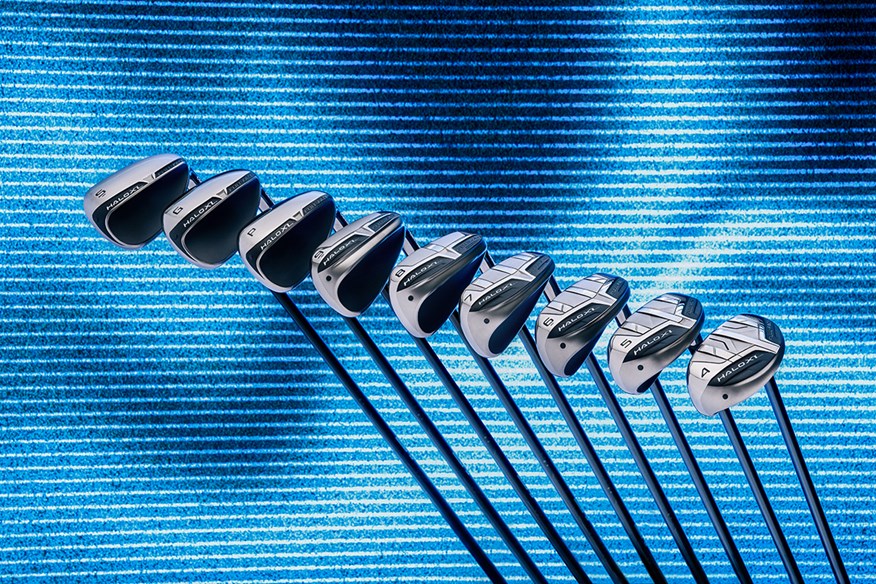Best Golf Irons 2025: The data-backed green finders that promise more looks at birdie this season
Last updated:
Which models make our 2025 best-in-class? Today’s Golfer tests and reveals the best golf irons on the market for ball strikers of all abilities to help you dial in on the pin.
Best Golf Irons:
- The Data
- How We Test
- Best Blade Irons
- Best Players’ Irons
- Best Players’ Distance Irons
- Best Mid-Handicap Irons
- Best High-Handicap Irons
- Buying Guide
- FAQs
As the PGA Tour’s strokes gained data demonstrates, the approach to the green is a pivotal part of shooting lower scores. Solid iron play is the glue that holds any golfer’s game together, whether that be limiting damage after a wayward drive or providing you with more makable birdie putts. Investing in a set of irons that complements your swing can be a huge win, and will undoubtedly help get your handicap moving in the right direction.
Irons are certainly the part of the bag that we hit the most, can’t deny or get around it (not without a significant investment in a collection of higher-lofted hybrids) so making the right choice is paramount. With so many degrees of forgiveness; variation in lofts; mixture of sole widths, toplines, and camber, the right choice isn’t always as cut and dry as ‘these go the furthest’ or ‘I feel like this was straighter.’
To help with your decision-making, we’ve put together this categorized shortlist of award-winning irons, backed by our test pro’s comparative launch monitor data and accompanying expert verdicts. If you’re well versed in the world of irons then feel free to jump straight into our shortlist otherwise, we suggest reading on before heading down to our ‘buying guide’ where you can read full descriptions about our five featured categories and everything else worth considering before committing to your purchase.
Best At A Glance: Our top pick from 2024’s award winners
Best Blade: Ping Blueprint T Irons | View Offer
Best Players-Style: Ping Blueprint S Irons | View Offer
Best Players-Distance: TaylorMade P790 Irons | View Offer
Best Mid-Handicap: TaylorMade Qi Irons | View Offer
Best High-Handicap: Callaway Paradym Ai-Smoke HL Irons | View Offer
How we tested the best golf irons
We asked the leading brands to send us their 2024 irons in our test Pro Neil Wain’s specs.
We created an indoor test lab at Keele Golf Centre to ensure a controlled environment, which meant we could use premium Titleist Pro V1x golf balls and a Foresight GC Quad launch monitor to create the most reliable data possible. We rejected major misses but recorded how shots launched, span, peaked out, and how far they flew in which direction.
See more about how TG tests golf clubs and other equipment.
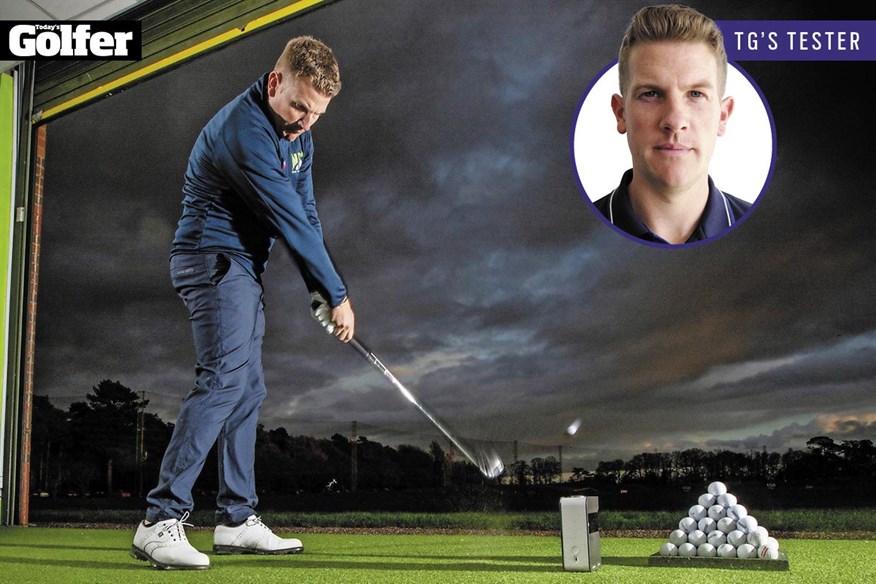
How to choose the best golf irons for your game
Choosing the right metal for the job is not always an obvious decision, however. Perhaps more than any other category of equipment, golf irons present a huge breadth and variety of options, from the most forgiving models pitched at high handicappers, to mid-handicap irons that serve the majority of club golfers, to blade and players’ models, typically reserved for the very best ball strikers. Being true to your ability level is key to making sure you arm yourself with the best irons for your game and ensuring you have no reason to upgrade before the end of their shelf life, typically around five years.
Once you’ve settled on the type of iron best suited to your game and have narrowed down a few options that appeal to you, we suggest reading through the full model review where you will find everything you need to know from the manufacturer’s R&D processes to the cutting-edge technology packed into each model. Powerhouse brands such as TaylorMade and Callaway typically manufacture families of their latest irons, meaning you can game a version of Rory or Rahm’s irons in a clubhead better suited to your ball-striking ability.
Finally, we suggest seeking out a comprehensive custom fitting session from a professional to test drive a selection of models in your chosen iron category before making an objective decision as to which model is best suited to your swing characteristics. Your club fitter will then be able to fine-tune your setup, ensuring you are in the right shaft to maximize their performance for you.
Best Golf Irons 2025: The Data
Below is the data from our independent testing of the best golf irons available in 2025. You can read about all the other models that didn’t make our shortlist above in our golf club review pages or category-specific irons pages.
How the Best Blade Irons compare in data (Test Pro data):
| Iron | 7-Iron Loft | Ball Speed | Launch Angle | Backspin | Peak Height | Descent Angle | Carry Distance | Carry Distance Drop Off | Shot Area |
| Ping Blueprint T | 33° | 120.7 MPH | 16.6° | 5630 RPM | 30 YDS | 44.1° | 178 YDS | 8 YDS | 98.4 SQ YDS |
| PXG 0317 ST | 33° | 118.9 MPH | 15.4° | 5619 RPM | 27 YDS | 42° | 174 YDS | 9 YDS | 184.5 SQ YDS |
| Wilson Staff Model Blade | 34° | 118.7 MPH | 16.9° | 5661 RPM | 30 YDS | 43.9° | 174 YDS | 14 YDS | 312.2 SQ YDS |
How the Best Players’ Irons compare in data (Test Pro data):
| Iron | 7-Iron Loft | Ball Speed | Launch Angle | Backspin | Height | Descent Angle | Carry Distance | Carry Distance Drop Off | Shot Area |
| PXG 0317 CB | 33° | 122.8 MPH | 16.6° | 5568 RPM | 32 YDS | 45.7° | 179 YDS | 7 YDS | 142.1 SQ YDS |
| Srixon ZX7 MK II | 32° | 122.9 MPH | 16.7° | 5757 RPM | 32 YDS | 46.1° | 178 YDS | 7 YDS | 57.4 SQ YDS |
| Ping Blueprint S | 33° | 121.3 MPH | 16.7° | 5498 RPM | 31 YDS | 45.1° | 177 YDS | 9 YDS | 188.1 SQ YDS |
| TaylorMade P770 | 33° | 122.3 MPH | 17.8° | 6143 RPM | 34 YDS | 47.5° | 175 YDS | 9 YDS | 200.7 SQ YDS |
| Mizuno Pro 243 | 32° | 122.2 MPH | 16.6° | 6035 RPM | 32 YDS | 46.3° | 174 YDS | 18 YDS | 387 SQ YDS |
How the Best Players’ Distance Irons compare in data (Test Pro data):
| Iron | 7-Iron Loft | Ball Speed | Launch Angle | Backspin | Height | Descent Angle | Carry Distance | Carry Distance Drop Off | Shot Area |
| Srixon ZX5 MK II | 31° | 122.8 MPH | 15.8° | 5292 RPM | 30 YDS | 44° | 181 YDS | 18 YDS | 392.4 SQ YDS |
| PXG 0311 P GEN 6 | 30° | 122.2 MPH | 14.6° | 5520 RPM | 28 YDS | 42.6° | 178 YDS | 10 YDS | 199 SQ YDS |
| TaylorMade P790 | 30.5° | 121.6 MPH | 15.1° | 5932 RPM | 29 YDS | 43.7° | 175 YDS | 8 YDS | 180.8 SQ YDS |
| Wilson Dynapower Forged | 30.5° | 120.8 MPH | 13.9° | 5482 RPM | 26 YDS | 41.1° | 175 YDS | 9 YDS | 188.1 SQ YDS |
| Mizuno Pro 245 | 30° | 119.3 MPH | 16.1° | 5481 RPM | 29 YDS | 43.6° | 173 YDS | 14 YDS | 271.6 SQ YDS |
How the Best Mid-Handicap Irons compare in data (Test Pro data):
| Iron | 7-Iron Loft | Ball Speed | Launch Angle | Backspin | Height | Descent Angle | Carry Distance | Carry Distance Drop Off | Shot Area |
| TaylorMade Qi | 28° | 129.2 MPH | 15.6° | 5065 RPM | 33 YDS | 44.2° | 198 YDS | 12 YDS | 267.6 SQ YDS |
| Callaway Paradym Ai Smoke | 28° | 130.6 MPH | 14.5° | 5311 RPM | 32 YDS | 43.4° | 197 YDS | 18 YDS | 552.6 SQ YDS |
| Ping G430 | 29° | 125.8 MPH | 14.9° | 5117 RPM | 30 YDS | 43.3° | 187 YDS | 7 YDS | 110.6 SQ YDS |
| Titleist T350 | 29° | 125.5 MPH | 14.3° | 5159 RPM | 29 YDS | 42.6° | 186 YDS | 11 YDS | 167.2 SQ YDS |
How the Best High-Handicap Irons compare in data (Test Pro data):
| Iron | 7-Iron Loft | Ball Speed | Launch Angle | Backspin | Height | Descent Angle | Carry Distance | Carry Distance Drop Off | Shot Area |
| Callaway Paradym AI Smoke HL | 30° | 127.4 MPH (1) | 14.8° | 5654 RPM | 32 YDS | 45.2° | 185 YDS (2) | 6 YDS (T1) | 103.8 SQ YDS (2) |
| Cleveland Halo XL Full Face | 29° | 123.9 MPH | 14.8° | 5079 RPM | 29 YDS | 42.2° | 184 YDS (3) | 13 YDS | 399.1 SQ YDS |
| Eleven | 31° | 127.2 MPH (T2) | 15.9° | 6454 RPM | 34 YDS | 47.4° | 180 YDS | 9 YDS | 169.2 SQ YDS |
Without further ado, Today’s Golfer presents our award-winning irons of 2025…
Best Golf Blade Irons 2025:
The fastest and longest blade we’ve tested this year.
Just like the original Blueprint, the new T has an incredibly good head shape, it’s really inviting sat behind the ball, and I just wish I was good enough to deploy the model on the golf course. Forged irons and Ping have never really been easy bedfellows as the company insisted for decades that cast irons could feel just as good as forged models. It’s intriguing then that the company now has three different irons with forged components (Blueprint T, Blueprint S, and i525), which for me marks a significant move away from the brand's decades-old stance on the material best suited to iron production.
I love the way that Ping doesn’t make a big deal about their forging process, not in the way a company like Mizuno has to with their Pro 241. All in our test pro felt he struggled to feel a difference between the T and the Mizuno Pro 241, which has to say sometimes the myth around forged blade feel is built up to levels that don’t really exist. Where Mizuno might have forged iron heritage, Ping has tons of great iron know-how, and based on our data I’d have no hesitation in recommending the Blueprint T to anyone looking at new muscleback blades in 2025.
For our test pro, the model was the fastest and longest blade we’ve tested this year, but if I were buying a set myself my eyes would be drawn more to the model offering up the 3rd smallest carry distance drop-off, and shot area size, numbers that will contribute to lowering scores rather than getting carried away about feel and feedback.
Read our full Ping Blueprint T iron review.
Pros
- Very good-looking iron.
- Minimal offset will suit good players.
- More forgiving than the original Blueprint.
Cons
- Some may be put off by the toe screw and notched hosel.
| Availability | 3-PW |
| Stock shafts | True Temper Dynamic Gold 120 (S300, X100) |
| 7-iron loft | 33° |
Perhaps the best muscleback iron on the market.
PXG knows a thing or two about making great irons. As is their calling card throughout their iron family the 317s have delicious straight-line head shapes, throughout the set and a really premium satin finish. Our pro loved the feel and feedback and it’s no exaggeration when I say he hit them incredibly well.
Speed and distance should never be factors when buying in the blade category but surely the 0317 has to score points for producing above-test average levels of ball speed and ranking tied 2nd longest for carry distance. The model also registered a shot area 26% smaller than our test average. Now don’t get me wrong I’m not saying this is a forgiving blade, it isn’t, but the data does support the reputation that PXG has built for making slightly straighter irons than most.
If I were spending my own money though the real deal sealer is PXG’s very clever central weighting system. Golfers can go lighter or heavier (which can boost ball speed, distance, and consistency), longer or shorter without moving the centre of gravity location and thus altering feel. To me, it’s a genius idea, and brilliant if you want to optimize a set for your own game in 2025.
Read our full PXG 0317 ST iron review.
Pros
- A beautiful traditional blade profile.
- Can be weighted up or down without changing the CG location.
- Even decent ball strikers will appreciate the cavity-back long irons.
Cons
- Unforgiving on off-center hits, so they're for high-skill ball strikers only.
| Availability | 3-PW |
| Stock shafts | True Temper Elevate 95 (s), KBS Tour Lite (s), Mitsubishi MMT (g), Project X Cypher (g), UST Recoil Dart (g) |
| 7-iron loft | 33° |
One of the best-performing blade irons in 2024.
Just like its predecessor the Staff Model is a great-looking blade, it comes with a highly polished chrome finish that’s as traditional as iron finishes get. Compared to the PXG 0317 ST the Wilson does have a more intimidating look at address, which is down to the topline thickness and sole widths being so wafer thin, but bear in mind Wilson’s staff players have fed directly into this design. Obviously, there’s an audience out there who like and favour the look, just beware that even if you’re looking to combo blade short irons with Wilson’s brilliant new Staff Model CB (Players’ Iron) mid and long irons, I would not describe the model in any way as being confidence-inspiring.
From a standard 34° 7-iron loft in the blade category the Staff Model produced a fraction more ball speed, more launch and shot height than our test averages, it also tied 2nd for carry distance. If your game happens to be good enough to consider employing a set of blades this year the Staff Model is one of my three best-performing blades in 2025.
Read our full Wilson Staff Model Blade iron review.
Pros
- Feel and impact are sensational.
- For an iron of this quality, the cost is very reasonable.
- Head shapes and profiles don't come any more traditional.
Cons
- These are amongst the least forgiving irons on the market.
| Availability | 4-PW (Custom Order 2 and 3 iron) |
| Stock shaft | True Temper Dynamic Gold Mid 115 |
| 7-iron loft | 34° |
How the best 2025 Blades compare to competitor models
| Iron | 7-Iron Loft | Ball Speed | Launch Angle | Backspin | Peak Height | Descent Angle | Carry Distance | Carry Distance Drop Off | Shot Area |
| Ping Blueprint T | 33° | 120.7 MPH (1) | 16.6° | 5630 RPM | 30 YDS | 44.1° | 178 YDS (1) | 8 YDS (T3) | 98.4 SQ YDS (3) |
| PXG 0317 ST | 33° | 118.9 MPH | 15.4° | 5619 RPM | 27 YDS | 42° | 174 YDS (T2) | 9 YDS | 184.5 SQ YDS |
| Wilson Staff Model Blade | 34° | 118.7 MPH | 16.9° | 5661 RPM | 30 YDS | 43.9° | 174 YDS (T2) | 14 YDS | 312.2 SQ YDS |
| Sub 70 639 MB | 32° | 119.3 MPH (3) | 14.8° | 5844 RPM | 26 YDS | 41.6° | 174 YDS (T2) | 9 YDS | 235.8 SQ YDS |
| Cobra King MB | 34° | 118.9 MPH | 17.1° | 6225 RPM | 31 YDS | 45° | 172 YDS | 8 YDS (T3) | 224 SQ YDS |
| Mizuno Pro 241 | 34° | 117.3 MPH | 17.6° | 5547 RPM | 30 YDS | 44.3° | 171 YDS | 11 YDS | 218.9 SQ YDS |
| Vega VMB | 31° | 119.5 MPH (2) | 15.3° | 6177 RPM | 28 YDS | 43.4° | 171 YDS | 5 YDS (1) | 50.5 SQ YDS (1) |
| TaylorMade P7MB | 34° | 118.5 MPH | 16.2° | 6490 RPM | 29 YDS | 44.1° | 170 YDS | 12 YDS | 235.2 SQ YDS |
| Callaway Apex 24 MB | 34° | 115.9 MPH | 17° | 6029 RPM | 29 YDS | 43.8° | 167 YDS | 18 YDS | 433.8 SQ YDS |
| Srixon Z-Forged | 33° | 116.7 MPH | 16.5° | 6123 RPM | 28 YDS | 43.6° | 167 YDS | 21 YDS | 588 SQ YDS |
| Titleist 620 MB | 35° | 115.6 MPH | 17.5° | 6362 RPM | 29 YDS | 44.7° | 165 YDS | 13 YDS | 318.5 SQ YDS |
| Takomo 301 MB | 34° | 115.9 MPH | 16.7° | 6637 RPM | 29 YDS | 44.7° | 163 YDS | 7 YDS (2) | 90.3 SQ YDS (2) |
| Average | 118 MPH | 16.5° | 6028.7 RPM | 28.8 YDS | 43.8° | 170.5 YDS | 11.25 YDS | 249.2 SQ YDS |
Best Players’ Irons 2025:
A stunning iron with all the hallmarks of being a timeless classic
I’ve been testing Ping irons for 15+ years and I can confidently say I’ve never been so excited by any of the brand's previous player-focused models. The Blueprint S has a beautifully simple head shape, gone completely is the ‘boxy’ or longer blade length shape that critics used to put the brand's better player models down for. In my mind, the S is right there alongside the Mizuno Pro 243 and Srixon ZX 7 MK II as one of the very best-shaped players’ irons of the year.
Our test pro loved the forged feel, and sound, preferring the impact sensation to his own set of cast i230’s, a model he’s played for nearly 18 months. Comparing the two sets the pair are almost identical in terms of data bar the four yards carry distance gain in favour of the S. Just remember choosing players’ irons should be more about shape, feel, ball flight, and consistency, so if ball speed and distance creep into your thinking, you really should be looking at players distance irons instead.
In terms of distance, the S carried shots comfortably above our test average (3 yards), with the carry distance drop-off and shot area being just below and above the test averages respectively. That sort of performance says to me the model is well decked out to perform across the board for consistent ball strikers.
Any decision between the S and i230 is likely to come down to how much premium you put on playing forged irons. Out on tour, this is huge, hence why the Blueprint S is seeing such success in the hands of the best players in the world. For decent club golfers price is also likely to be a factor as a 7-piece steel shafted set will set you back £140 more by opting for the forged S. When you’re making your decision don’t forget to factor in the new pocket cavity tech in the S long irons, which will offer up a little more forgiveness.
In my book, the Blueprint S is a stunning set of irons, thanks to being forged and deliciously well shaped they have all the hallmarks of being a timeless classic set, hence why they’re among my five best players’ irons of 2025.
Read our full Ping Blueprint S iron review.
Pros
- This is Ping's first forged cavity back iron in a decade.
- An excellent blend of sound, feel, and forgiveness within the chassis of a tour iron.
- Toe and shaft tip weights cleverly up MOI.
Cons
- Ping forged irons always represent a sizeable investment.
| Availability | 3-PW |
| Stock shaft | True Temper Dynamic Gold 120 |
| 7-iron loft | 33° |
An absolute beast of a tour-level forged iron.
TG Top Gear 2024: Best Players' Irons
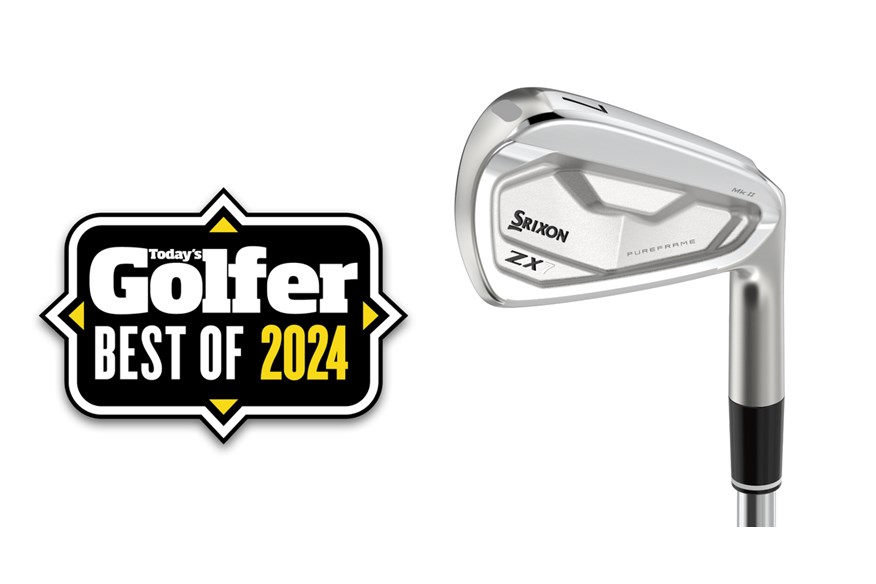

Why do we like it so much? Well, it’s got natural elegance, with a super straight topline, compact shape, and a lack of offset, all features that many decent players just adore. Importantly it also has a timeless classic design which isn’t going to feel old hat next year either.
Throw into the mix a third-best ball speed performance in the players’ iron category in 2025. A fourth-best carry distance, plus a 23.2% smaller carry distance drop-off and 67.1% smaller shot area than our test averages and you can see in the right hands the ZX7 is an absolute beast of a tour-level forged iron.
On top of everything else, our test pro thought the feel and feedback from the ZX7 was out of this world good, and right up there alongside the Mizunos of this world. If you find yourself dithering on the line between this model and its more speed and distance-focused sibling the ZX5 our data shows you’ll give three up yards or so distance but gain 500 RPM of backspin to play the ZX7. For proper players’ you’ll probably want the additional control brought by that extra spin.
Read our full Srixon ZX7 MKII irons review.
Pros
- Exceptional feel.
- Brilliant all-round performance.
- Fantastic looking with its timeless design.
Cons
- Slightly more speed and distance to be found in the ZX5.
| Availability | 3-PW |
| Stock shaft | Nippon NS Pro Modus3 Tour |
| 7-iron loft | 32° |
One of the best-performing players' irons of 2025.
TG Top Gear 2024: Best Players' Irons
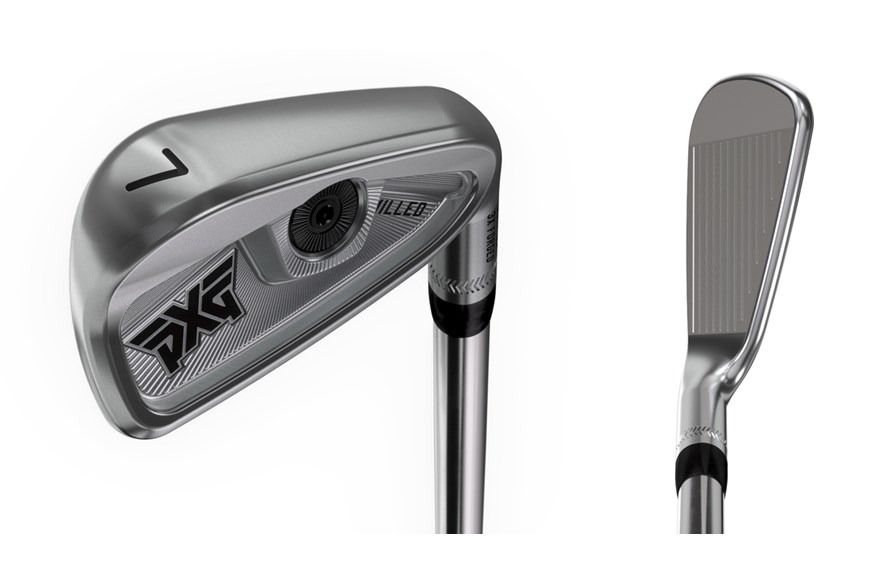

Through working with their ‘elite’ players PXG has come to understand that a majority of very good players just want a forged compact cavity back iron to play on tour. As good as hollow body constructions are, with their fast faces, many of the best players in the world just want consistency from their irons. So, fair play to PXG for listening to their team and creating a 0317 family just for elite players.
In typical PXG style, there are three 0317 irons calling out for the attention of golfers looking within the players’ iron category (0317 ST, 0317 CB, 0317 T) in 2024. Incredibly the T and CB both fly high at the top of our data sheet in the Players’ Iron category this year.
While both are lovely looking, feeling, and sounding irons I’ve plumped for the 0317 CB as picking within this category really shouldn’t come down to speed and distance. Yes, the slightly stronger lofted, hollow body 0317 T was 2.2mph faster on ball speed, it also produced three more yards of 7-iron carry distance, but our test pro still just felt the CB is a better choice for low single-digit handicappers looking for maximum control and shot to shot consistency.
From a 7-iron loft bang on our test average the one-piece forged CB head produced a ball speed faster than the test average, yet launched and flighted shots higher, with a steeper descent angle so hitting shots into a green will be much like throwing darts at a board. Combine that performance with a smaller carry distance drop-off and tighter shot area than our test averages and you have one of the best-performing players’ irons of 2025 on your hands. Great work, with congratulations being due to PXG for their first forged cavity back iron endeavour.
Pros
- Excellent control and shot consistency.
- High flights with steep decent angles.
- Strong carry distances.
Cons
- Not the fast ball speeds within the 0317 family.
| Availability | 3-PW |
| Stock shaft | True Temper Elevate 95 (s), KBS Tour Lite (s), Mitsubishi MMT (g), Project X Cypher (g), UST Recoil Dart (g) |
| 7-iron loft | 33° |
Quick and powerful with excellent control and workability.
I’m no Mizuno knocker but there’s no getting away from how the brand's iron launches over the last few years have become a bit predictable. Within the JPX family, I’ve seen the 919, 921, and 923 families covered over the last six years. We’re also now into the 2nd generation of Pro irons which by the time they’re retired will have spanned an additional 4 years too.
Hand on heart if I bought an original set of either franchise, I’d really struggle to say any subsequent generation, bar the introduction of springy chromoly steel, has been a huge step forward in terms of performance. That’s not a slight on the most recent updates but if you own previous models I reckon you don’t have to keep updating to the latest and greatest. However, if you’re new to Mizuno or just looking for a great set of players’ irons in 2025 the Pro 243s represent a very solid choice in 2025.
Cast your eye over our test data and you won’t find the Mizuno Pro 243 on the podium for any single metric. Yet our test pro was adamant the model felt quick and powerful (it produced a faster-than-average ball speed) and offered him the ball flight, control and look he wanted from a forged cavity back tour-level iron. To back up his thinking, compared to the 2° weaker Mizuno JPX923 Tour iron the Pro 243 hit shots higher, with a steeper decent angle and additional spin, features lots of decent players will appreciate. Factor in top draw levels of feel and you have an iron that’s well worth a position among our favourite five players’ irons of 2025.
If you’re looking at this category in 2025 it’s really hard to make a bad choice, as there are so many good irons within the players’ iron arena. I’d be drawn to the Mizuno Pro 243 not only because it’s a very solid performer across the board, but because there’s also a two life expectancy ahead of it. If though you’re the type of person who likes to have the very latest model in their bag, bear in mind the JPX family is also due for replacement later this summer.
Read our full Mizuno Pro 243 irons review.
Pros
- Expect beautifully shaped heads.
- Guaranteed great feel and feedback.
- Lots of shaft options at zero upcharge.
Cons
- All the Mizuno Pro irons are seriously costly options in 2024.
| Availability | 4-PW |
| Stock shaft | Dynamic Gold Mid 115 |
| 7-iron loft | 32° |
A modern beauty that stands up to the best on offer in 2025.
In previous years the P770 has been tough to categorize, but thanks to its players' profile (and weak 33° 7-iron loft), which TaylorMade crams with ball speed and forgiveness-enhancing tech, this is clearly a modern-day players’ iron. And if you’re happy to accept tech within the players’ iron arena the P770 is just about as good as they come.
For those who question what hollow body constructions and thin fast faces bring to the party, comparing the P770 to TaylorMade’s P7MC gives a great explanation of what tech does for the category. Thanks to tungsten weighting inside and a hollow body construction the P770 has a slightly higher MOI. Which is good for golfers who hit lots of straight shots, but less attractive for golfers who like shaping shots onto a flag.
In our 2024 test, the P770 produced a ball speed 2.8 mph faster than the 1° weaker loft P7MC. Thanks to the hollow body and thin face shots launched with a fraction less spin, yet peaked out higher, and hit the green at a steeper angle (0.4deg), while adding 6 yards of additional 7-iron carry distance. In my book, those are all seriously impressive stats that will help decent club golfers score a fraction lower, more often. Whichever way you want to look at it the P770 is a modern beauty, and even if they are due to be replaced later in the year I still regard them as one of the best players’ irons of 2024.
Read our full TaylorMade P770 irons review.
Pros
- Good levels of forgiveness for a player's iron.
- High ball flight apex and steep descent angles.
- Packed with ball speed and forgiveness-enhancing tech.
Cons
- Not ideal for those who like to shape shots.
| Availability | 3-PW |
| Stock shaft | KBS Tour |
| 7-iron loft | 33° |
How the best 2024 Players’ Irons compare to competitor models
| Iron | 7-Iron Loft | Ball Speed | Launch Angle | Backspin | Height | Descent Angle | Carry Distance | Carry Distance Drop Off | Shot Area |
| PXG 0317 T | 32° | 125 MPH (1) | 15.6° | 5343 RPM | 32 YDS | 45.1° | 182 YDS (1) | 6 YDS | 118.2 SQ YDS |
| PXG 0317 CB | 33° | 122.8 MPH | 16.6° | 5568 RPM | 32 YDS | 45.7° | 179 YDS (T2) | 7 YDS | 142.1 SQ YDS |
| Vega VDC | 31° | 124.4 MPH (2) | 14.8° | 5703 RPM | 30 YDS | 44.4° | 179 YDS (T2) | 8 YDS | 236.8 SQ YDS |
| Srixon ZX7 MK II | 32° | 122.9 MPH (3) | 16.7° | 5757 RPM | 32 YDS | 46.1° | 178 YDS | 7 YDS | 57.4 SQ YDS |
| Sub 70 659 CB | 32° | 122.8 MPH | 15.3° | 5683 RPM | 30 YDS | 44.2° | 178 YDS | 8 YDS | 70.4 SQ YDS |
| More MOD 1 | 32° | 121.5 MPH | 15.9° | 5370 RPM | 30 YDS | 44.1° | 178 YDS | 2 YDS (1) | 48.4 SQ YDS (2) |
| Ping Blueprint S | 33° | 121.3 MPH | 16.7° | 5498 RPM | 31 YDS | 45.1° | 177 YDS | 9 YDS | 188.1 SQ YDS |
| Titleist T150 | 32° | 122.6 MPH | 17.5° | 5686 RPM | 34 YDS | 46.8° | 177 YDS | 4 YDS (2) | 53.6 SQ YDS (3) |
| Takomo 201 | 32° | 122.6 MPH | 15.7° | 6070 RPM | 31 YDS | 45° | 176 YDS | 9 YDS | 119.7 SQ YDS |
| Cobra King Tour | 32° | 120.9 MPH | 15.4° | 5534 RPM | 29 YDS | 43.1° | 176 YDS | 9 YDS | 253.8 SQ YDS |
| TaylorMade P770 | 33° | 122.3 MPH | 17.8° | 6143 RPM | 34 YDS | 47.5° | 175 YDS | 9 YDS | 200.7 SQ YDS |
| Mizuno JPX923 Tour | 34° | 121 MPH | 16.2° | 5704 RPM | 30 YDS | 44.6° | 175 YDS | 9 YDS | 171 SQ YDS |
| Vega VSC | 31° | 121.7 MPH | 15.2° | 5943 RPM | 29 YDS | 43.8° | 175 YDS | 14 YDS | 387.8 SQ YDS |
| Callaway Apex 24 Pro | 33° | 122.4 MPH | 16.2° | 6026 RPM | 27 YDS | 43.3° | 174 YDS | 7 YDS | 128.1 SQ YDS |
| Callaway Apex TCB | 34° | 121.9 MPH | 16.6° | 5189 RPM | 32 YDS | 46.1° | 174 YDS | 5 YDS (3) | 46 SQ YDS (1) |
| Mizuno Pro 243 | 32° | 122.2 MPH | 16.6° | 6035 RPM | 32 YDS | 46.3° | 174 YDS | 18 YDS | 387 SQ YDS |
| Ping i230 | 33° | 121.3 MPH | 16.4° | 5821 RPM | 31 YDS | 45.7° | 173 YDS | 19 YDS | 248.9 SQ YDS |
| Sub 70 639 CB | 32° | 122.3 MPH | 15.4° | 6584 RPM | 30 YDS | 45.4° | 173 YDS | 13 YDS | 266.5 SQ YDS |
| Callaway Apex 24 CB | 34° | 120.6 MPH | 16.7° | 6235 RPM | 31 YDS | 46.2° | 170 YDS | 9 YDS | 151.2 SQ YDS |
| Takomo 301 CB | 34° | 120 MPH | 17.3° | 6410 RPM | 32 YDS | 46.4° | 170 YDS | 7 YDS | 152.6 SQ YDS |
| TaylorMade P7MC | 34° | 119.5 MPH | 18° | 6226 RPM | 33 YDS | 47.2° | 169 YDS | 11 YDS | 135.3 SQ YDS |
| Wilson Staff Model CB | 34° | 118.6 MPH | 16.3° | 6221 RPM | 29 YDS | 44.8° | 169 YDS | 6 YDS | 76.8 SQ YDS |
| Titleist T100 | 34° | 118.1 MPH | 17.3° | 5677 RPM | 31 YDS | 45.4° | 169 YDS | 8 YDS | 107.2 SQ YDS |
| Ben Hogan PTX Tour | 33.5° | 117.9 MPH | 16° | 5767 RPM | 28 YDS | 43.5° | 169 YDS | 11 YDS | 335.5 SQ YDS |
| Titleist 620 CB | 34° | 117.9 MPH | 17.9° | 6127 RPM | 32 YDS | 46.5° | 167 YDS | 13 YDS | 274.3 SQ YDS |
| Average | 121.4 MPH | 16.4° | 5853 RPM | 30.9 YDS | 45.3° | 174.2 YDS | 9.1 YDS | 174.3 SQ YDS |
Best Players’ Distance Irons 2025:
A punchy players' distance irons that will fight it out with the best.
His thinking came down to loving the punchy feel of the Pro, and how its slightly weaker 7-iron loft gave him the hanging rather than boring ball flight he prefers. Our test data utterly supports what his eyes and gut feel were telling him. Unless you specifically want to lower ball flight with the JPX923 Hot Metal Pro, the 245 launched and flew higher (1.5° and 1 yard respectively) span 600 RPM more, and hit the green at a 1.8° steeper descent angle, all numbers that will help golfers score better on the golf course. Ok, the JPX was 13 yards longer (with a 7-iron) but its dispersion/shot area was also 63.4% bigger which is a huge price to pay in the area of the bag most golfers crave accuracy.
Tons of golfers will be weighing up a choice between the Pro 245 and other leading hollow body irons like the TaylorMade P790, Titleist T200, Ping i525, and PXG 0311 P GEN6 this year. My advice to anyone trying to fathom this conundrum is to go and try them side by side. Very quickly you’ll narrow your choice to a couple of favourite options based on head shape, feel, and ball flight traits.
From there be led by your ability to customize. All in, you can’t make a bad choice, these are great irons, hence why they all feature on my shortlist of top-performing Players’ Distance Irons of 2025.
Read our full Mizuno Pro 245 irons review.
Pros
- Expect beautifully shaped heads.
- Guaranteed great feel and feedback.
- Lots of shaft options at zero upcharge.
Cons
- All the Mizuno Pro irons are seriously costly options in 2024.
| Availability | 3-PW |
| Stock shaft | Dynamic Gold Mid 100 |
| 7-iron loft | 30° |
Players’ Distance Irons just don’t come any better.
There’s a real beauty in how the model from day one has been designed to be a timeless classic. The idea means there aren’t huge changes from generation to generation and if you happen to own a set of the original 2017 P790s they’re just as good today as what they were when golfers went nuts for the marquee seven years ago.
The untrained eye will likely look at our data charts and wonder why thanks to being in a ‘distance category’ the P790 which posted almost bang-on average carry warrants such praise. Let me explain. At 30.5° in the 7-iron the P790 is nowhere near the strongest loft players distance iron we tested this year, in fact, it’s 2° weaker than the Mizuno JPX923 Hot Metal Pro that also produced the fastest ball speed and longest carry distance. But look more closely and you’ll see how the P790 produced a ball speed above our test average while flying shots higher, spinning more and hitting the green at a steeper angle so shots will stop when they hit the dancefloor.
When we put the P790's aesthetics, feel, and sound into the mix along with a tied 2nd performance for carry distance drop-off and a shot area 45.4% tighter than our test average (2nd best) you really can’t question this model's credentials. Players’ Distance Irons just don’t come any better.
Read our full TaylorMade P790 irons review.
Pros
- Having the option of trying stronger and weaker lofts during a fitting is genius thinking.
- The players' distance iron that has more proven pedigree than all of its competitors.
- A slightly lighter regular flex shaft opens the model up to more average swing speed players.
Cons
- A truly difficult iron to fault.
A super-playable iron within the players' distance category.
The 0311 iron family has won a stack of awards previously here at TG and the most recent GEN6 P is just about the best the company has to offer in the hollow body iron arena. Nobody I’ve ever spoken to doesn’t like the look or shape of PXG irons, it’s something designer/engineer Mike Nicolette has worked on tirelessly and absolutely nailed from day one. That profile shape is very slightly longer than some (which helps forgiveness), there’s a lovely crisp toe shape and beautifully clean blend into the hosel, which means the P is open to being used by quite a wide audience of players.
In terms of performance, the P stuck stubbornly on our test averages for launch angle, backspin, shot height, and descent angle, but was faster, longer and produced a tighter carry distance drop-off and shot area. To me that says the model will be super playable out on the golf course versus some of the other models in this category.
The Players’ Distance Iron arena is incredibly crowded, there are lots of good options here. I’d choose PXG not only for the cracking sound and feel of their P offering, which is made possible thanks to the brand's dedication to filling their models with lightweight polymer but also because the company has developed a second-to-none fitting system that allows golfers to go lighter, heavier, longer or shorter in their irons without the need to move the centre of gravity. Yes, you’ll need a fitting to access this type of set-up but in my book, that’s time very well invested in helping get more from your iron play this year.
Read our full PXG 0311 GEN6 P irons review.
Pros
- We love how golfers can go lighter or heavier in weight and longer or shorter in shaft length without moving the center of gravity location.
- The 0311 GEN6 P and XP are some of the best looking, feeling, and sounding players' distance and mid-handicap irons available.
- PXG fitting experiences are second to none.
Cons
- Keep an eye on PXG's website, prices are prone to fluctuate and fall on a regular basis.
| Availability | 3-PW |
| Stock shafts | True Temper Elevate Tour and Elevate MP 95g, KBS Tour Lite, Nippon Modus Pro 125 |
| 7-iron loft | 30° |
A timeless classic that will still appeal to high-level players in its second year.
On paper as solid as the model was, there’s no hiding it produced a fraction less spin than our test average. Now that need not be a major issue, so long as you have reasonable levels of speed as this is one of the weakest lofted models in the distance category.
Our data spells out how shots launched and flew a little higher and hit the green at a steeper angle than average so it’s not like shots cannon off the springy face like low-spin bullets. Not too many irons are award winners here at TG in their second year but I love the ZX’s combination of forged head with a thin, fast, and springy face for excellent speed and distance.
The model is a great marriage, creating one of the very best timeless classic players’ distance irons available, so golfers don’t need to worry about the model feeling out of date next season. The ability to buy individual irons and combo any of Srixon’s three ZX models together still makes the ZX a brilliant buy in 2025.
Read our full Srixon ZX5 MKII irons review.
Pros
- Classic, understated, and timeless looks.
- Available to mix and match with any of Srixon's ZX models.
- Still winning awards in its second year of play.
Cons
- Lower spinning than our test average.
| Availability | 3-PW |
| Stock shafts | KBS Tour Lite (s) UST Recoil Dart (g) |
| 7-iron loft | 31° |
A traditional player's distance iron in every sense.
What Wilson very cleverly does though is build some ball speed and distance tech into this forged beauty, they also deck it out in a traditional shiny, highly polished finish that gives a timeless classic appearance. Some golfers will say the finish glares in very bright sunlight but there’s no getting away from the Dynapower Forged blending tech and tradition seamlessly into a single desirable model.
I can’t say the Forged was the fastest or longest in the category, but that doesn’t stop it from offering itself up as a very attractive Players’ Distance package in 2025. Based on the data, I see the Dynapower being a great option for slightly better golfers than those who might be attracted to a TaylorMade P790 or PXG 0311 P. My thinking is the head is pretty compact, and our test pro didn’t feel there was quite as much forgiveness or ball speed protection on offer as a hollow body alternative. Our data also highlights a slightly lower, less hanging ball flight which tends to be desirable for more serious golfers than those just wanting to look the part of a low double-digit handicapper with a great set of irons in their bag.
Costs have sky-rocketed over recent years and where £900 for a set of Wilson irons would have been inconceivable just five years ago, today versus the £1200 plus prices of many of the competition this is a really good solid players’ distance iron option in 2025.
Read our full Wilson Dynapower Forged irons review.
Pros
- Competitively priced in the current market.
- Every bit as good as the top-performing players' distance irons on the market.
- The KBS Tour Lite shaft is of decent quality.
Cons
- The traditional polished chrome finish is just a little old hat and prone to glaring in bright sunlight.
| Availability | 5-PW, GW (with custom order 3 and 4 iron) |
| Stock shafts | KBS Tour Lite (s) UST Recoil Dart 75 (g) |
| 7-iron loft | 30.5° |
How the best 2024 Players’ Distance Irons compare to competitor models
| Iron | 7-Iron Loft | Ball Speed | Launch Angle | Backspin | Height | Descent Angle | Carry Distance | Carry Distance Drop Off | Shot Area |
| Mizuno JPX923 Hot Metal Pro | 28.5° | 124.1 MPH (1) | 14.6° | 4881 RPM | 28 YDS | 41.8° | 186 YDS (1) | 22 YDS | 741.4 SQ YDS |
| Srixon ZX5 MK II | 31° | 122.8 MPH (3) | 15.8° | 5292 RPM | 30 YDS | 44° | 181 YDS (T2) | 18 YDS | 392.4 SQ YDS |
| Callaway Paradym | 29° | 123 MPH (2) | 14.2° | 5120 RPM | 27 YDS | 41.5° | 181 YDS (T2) | 15 YDS | 360 SQ YDS |
| Mizuno JPX923 Forged | 30° | 122.4 MPH | 14.5° | 5117 RPM | 27 YDS | 41.8° | 180 YDS | 7 YDS (1) | 210 SQ YDS |
| PXG 0311 P GEN 6 | 30° | 122.2 MPH | 14.6° | 5520 RPM | 28 YDS | 42.6° | 178 YDS | 10 YDS | 199 SQ YDS |
| Vega Mizar Tour | 30° | 122.3 MPH | 13.5° | 5381 RPM | 26 YDS | 40.8° | 178 YDS | 13 YDS | 360.1 SQ YDS |
| Sub 70 699 Pro | 30° | 121.8 MPH | 14.9° | 5349 RPM | 28 YDS | 42.6° | 178 YDS | 10 YDS | 166 SQ YDS (1) |
| Yonex Ezone CB702 | 31° | 122.6 MPH | 15.6° | 5820 RPM | 30 YDS | 44.4° | 177 YDS | 23 YDS | 533.6 SQ YDS |
| TaylorMade P790 | 30.5° | 121.6 MPH | 15.1° | 5932 RPM | 29 YDS | 43.7° | 175 YDS | 8 YDS (T2) | 180.8 SQ YDS (2) |
| Wilson Dynapower Forged | 30.5° | 120.8 MPH | 13.9° | 5482 RPM | 26 YDS | 41.1° | 175 YDS | 9 YDS | 188.1 SQ YDS (3) |
| Ping i525 | 30.5° | 120 MPH | 15° | 5666 RPM | 28 YDS | 42.7° | 173 YDS | 11 YDS | 217.8 SQ YDS |
| Titleist T200 | 30.5° | 119.7 MPH | 15.4° | 5760 RPM | 28 YDS | 43.3° | 173 YDS | 13 YDS | 331.5 SQ YDS |
| Cobra Forged Tec | 29.5° | 119.4 MPH | 14.7° | 5558 RPM | 27 YDS | 41.9° | 173 YDS | 20 YDS | 612 SQ YDS |
| Mizuno Pro 245 | 30° | 119.3 MPH | 16.1° | 5481 RPM | 29 YDS | 43.6° | 173 YDS | 14 YDS | 271.6 SQ YDS |
| Takomo 101 T | 32° | 116.7 MPH | 16° | 6383 RPM | 28 YDS | 43.9° | 165 YDS | 8 YDS (T2) | 203.2 SQ YDS |
| Average | 121.2 MPH | 14.9° | 5516.1 RPM | 27.9 YDS | 42.6° | 176.4 YDS | 13.4 YDS | 331.2 SQ YDS |
Best Mid-Handicap Irons 2025:
A cap-back game improver that promises to deliver straight distance.
The Qi has a huge amount going for it. The model has a really attractive and desirable head shape and profile, yet it maintains good levels of hosel offset to help flight shots higher for additional carry distance.
I love the way, that thanks to TaylorMade’s SelectFit adjustable hosel system, golfers can also try this model at weaker or stronger lofts. The idea allows golfers to see before they buy the effect loft and lie adjustments have on performance and data which means this versatile model is well suited to a vast audience of abilities, speeds, and deliveries. It also means you might well not need to opt for the slightly larger Qi XL to play TaylorMade’s most lofted and easy-to-flight game improvement iron.
As nice as TaylorMade’s ‘Qi = Straight Distance’ tagline is, please remember it only really comes into play in the mid and longer irons, as shorter irons don’t have a right-sided bias. If you don’t use long irons the concept could be a bit wasted on you. If you do then the Qi will help hit shots a little straighter and closer to your target as long irons are inherently tough to hit accurately, especially from the turf.
Our test pro’s hitting data shines a light on how the Qi is a super quick and powerful iron option in 2025. At 198 yards it was tied at the top of the pile as the longest mid-handicap iron we hit this year. The model also posted our 3rd fastest ball speed, impressive when you factor in it isn’t the very strongest lofted 7-iron within the category.
Those headline numbers are all well and good, but my eye is drawn to how the model launched and flew higher than our test averages. That performance led to shots hitting the green at a steeper angle making the Qi playable in a way traditional strong lofted irons never were a decade ago. Throw in a dispersion/shot area 2.2% tighter than our test average and it’s not too hard to spot why I feel the model warrants a position among our best-performing mid-handicap irons of 2025. Thanks to TaylorMade’s new two-year product cycle strategy the Qi also won’t feel old hat or out of date until deep into 2025.
Read our full TaylorMade Qi irons review.
Pros
- Available in stronger and weaker lofts for gapping purposes
- A bulletproof iron that will stand the test of time
- Extremely good-looking forgiving iron for mid-handicap golfers
Cons
- Offset could be off-putting for some golfers
| Availability | 4-LW |
| Stock shafts | KBS Max 85 (s), Fujikura Ventus Blue TR (g) |
| 7-Iron loft | 28° |
The most forgiving and playable iron set offered by Titleist.
As golfers most of us want to play clubs we like the look of, especially when we’re often forking out over $1K/£1K for a decent set of irons. And if it’s looks you’re after there are not many better looking or more attractive mid-handicap iron options on the market than the T350. I really like the straight top edge, how there isn’t a ton of hosel offset, and how even though the head's bigger than the Titleist T200 it’s still really attractive and easy on the eye when sat behind the ball.
Our test data shows the T350 almost to a tee follows our test averages, which to many might not scream top performer. But throw in a forged face, a ton of tungsten toe weighting to up MOI, and an array of top fitting options (which many in the category can’t compete with), and this model should at least be on mid-handicappers' shortlist to try.
Personally, I’ve played the model since August 2023 and I really like the sound and feel along with how the slightly weaker lofts than some of the competition help flight shots for maximum playability and not just most speed or distance. To take full advantage of what Titleist has to offer ensure you get properly fitted as the brand prides itself on being custom fit leaders.
Read our full Titleist T350 irons review.
Pros
- Premium finish and quality you'd expect from Titleist.
- Lovely sound and feel.
- Workable lofts.
Cons
- Not a standout performer but does everything well.
| Availability | 4-PW, GW, SW |
| Stock shafts | True Temper AMT Red (s), Mitsubishi Tensei Red AM2 (g) |
| 7-Iron loft | 29° |
Delivers great forgiveness while improving looks, sound, and feel.
The G430 wasn’t our fastest or longest mid-handicap model but its numbers consistently hovered around the test averages for every metric except dispersion, where the model excelled. I’ve tested the G430 for a couple of years now and while some will say the blade lengths of the mid and longer irons are a little longer than some (which helps nudge up MOI and forgiveness) I’d happily recommend them and spend my own money on a set, safe in the knowledge Ping irons hold their value better than almost any other golf equipment.
Just remember if you find the lofts are a fraction strong for your average swing speed, all Ping irons come with the option of Retro (weaker) and Power (stronger) lofts, and if you’re really struggling to flight shots for maximum carry distance there’s also a lighter and more lively HL version too. If your game teeters at the edges of the mid-handicap Iron category it’s well worth noting there’s a new i530 Players Distance Iron and G730 Super Game Improvement on their way in April 2024.
Read our full Ping G430 irons review.
Pros
- Very forgiving
- Arguably the best-looking G series iron Ping has ever produced.
- Good loft options with retro and power specs available.
Cons
- Spin could be higher but this is achievable with weaker lofts.
| Availability | 4-LW |
| Stock shafts | Ping AWT (s), Ping Alta Quick (g), Ping Alta CB Black (g) |
| 7-Iron loft | 29° |
Callaway's fast, forgiving, and powerful beast of an iron.
With the cast, hollow body, and strong loft, Ai-Smoke is aimed squarely at mid-handicap players and game improvers who won’t entertain spending more than $1K/£1K on a set of irons. And from what I’ve seen it’s a cracking option for golfers who possess a decent degree of club speed.
Thanks to producing the fastest ball speed (130.6mph) of the entire mid-handicap iron category while being just a single yard back from posting the longest 7-iron carry I can safely say the Ai-Smoke is a very powerful beast in the right hands. The whole idea of the club’s hollow body and fast face is that shots launch higher with less spin, so the ball travels further. But what’s really encouraging to my eye is how the Smoke produced bang-on-average launch, spin, and descent angle numbers so shots aren’t just flying like low-spin bullets, that won’t stop on a green.
To my eye, the Ai-Smoke isn’t the most attractively shaped or desirably designed iron in the mid-handicap iron market. But our test pro is using the 4-iron as a powerful long iron option this season, which has to say the model can do a job for any golfer who boasts decent amounts of speed to launch the strong lofts from the turf. For those who don’t, check out the more lofted Ai-Smoke HL and lighter Ai-Smoke Max Fast instead.
Undoubtedly there will be critics that hold up the Ai-Smoke’s 18-yard carry distance drop-off as the drawback of using uncontrollable modern, fast face, hollow body irons. But remember our data is created using a a test pro. Club golfers at lesser speeds are very likely to see smaller differences between on and off-centre hits, and our second most accurate iron in the category (the Ping G430) also boasts similar thin, fast face tech. From what I’ve seen I have zero reservations in naming the Ai-Smoke among my best four Mid-Handicap irons of 2024.
Read our full Callaway Paradym Ai-Smoke iron review.
Pros
- A sleek new look for Callaway game improvement irons.
- A lot of iron for less than $1K/£1K.
- Slightly weaker lofts make it easier to gap these irons.
Cons
- Make sure you have enough speed to launch this model successfully.
| Availability | 5-AW, SW |
| Stock shaft | True Temper Elevate (s) | Project X Cypher 2.0 (g) | Mitsubishi Tensei Blue White (g) |
| 7-Iron loft | 28° |
How the Best 2024 Mid-Handicap irons compare to competitor models
| Iron | 7-Iron Loft | Ball Speed | Launch Angle | Backspin | Height | Descent Angle | Carry Distance | Carry Distance Drop Off | Shot Area |
| TaylorMade Qi | 28° | 129.2 MPH (3) | 15.6° | 5065 RPM | 33 YDS | 44.2° | 198 YDS (T1) | 12 YDS | 267.6 SQ YDS |
| PXG 0211 XCOR2 | 28° | 130.1 MPH (2) | 13.6° | 5057 RPM | 29 YDS | 41.8° | 198 YDS (T1) | 16 YDS | 193.6 SQ YDS |
| Callaway Paradym Ai Smoke | 28° | 130.6 MPH (1) | 14.5° | 5311 RPM | 32 YDS | 43.4° | 197 YDS (3) | 18 YDS | 552.6 SQ YDS |
| Wilson Dynapower | 27° | 127.8 MPH | 15° | 4910 RPM | 31 YDS | 42.7° | 195 YDS | 8 YDS (T3) | 196.8 SQ YDS |
| Cobra Forged Tec X | 27° | 127.7 MPH | 13.9° | 4872 RPM | 29 YDS | 42.1° | 191 YDS | 9 YDS | 360 SQ YDS |
| PXG 0311 XP GEN6 | 27° | 126.2 MPH | 13.7° | 4726 RPM | 27 YDS | 40.8° | 190 YDS | 20 YDS | 470 SQ YDS |
| Mizuno JPX923 Hot Metal | 28.5° | 127.6 MPH | 14.9° | 5748 RPM | 31 YDS | 44.2° | 190 YDS | 13 YDS | 243.1 SQ YDS |
| Srixon ZX4 | 28.5° | 126.4 MPH | 14.7° | 5030 RPM | 30 YDS | 43.1° | 189 YDS | 22 YDS | 594 SQ YDS |
| Ram FXT | 126.1 MPH | 15.4° | 5395 RPM | 31 YDS | 43.7° | 189 YDS | 13 YDS | 161.2 SQ YDS | |
| Cleveland XL ZipCore | 29° | 125.1 MPH | 14.6° | 4719 RPM | 29 YDS | 41.8° | 188 YDS | 15 YDS | 210 SQ YDS |
| Ping G430 | 29° | 125.8 MPH | 14.9° | 5117 RPM | 30 YDS | 43.3° | 187 YDS | 7 YDS (2) | 110.6 SQ YDS (2) |
| Inesis 500 | 125.1 MPH | 15.6° | 5456 RPM | 31 YDS | 43.5° | 187 YDS | 8 YDS (T3) | 181.6 SQ YDS | |
| Titleist T350 | 29° | 125.5 MPH | 14.3° | 5159 RPM | 29 YDS | 42.6° | 186 YDS | 11 YDS | 167.2 SQ YDS |
| Cobra Darkspeed | 27° | 126.7 MPH | 12.4° | 5298 RPM | 26 YDS | 40.7° | 186 YDS | 8 YDS (T3) | 129.6 SQ YDS |
| Takomo 101 | 30° | 123.8 MPH | 14° | 4784 RPM | 27 YDS | 40.8° | 184 YDS | 4 YDS (1) | 52.4 SQ YDS (1) |
| Yonex GS i-Tech | 125.2 MPH | 13.8° | 5373 RPM | 28 YDS | 42.2° | 184 YDS | 21 YDS | 611.1 SQ YDS | |
| Vega Mizar Plus | 30° | 125.4 MPH | 14.3° | 5858 RPM | 29 YDS | 43.8° | 182 YDS | 22 YDS | 420.2 SQ YDS |
| Sub 70 699 | 31° | 124.1 MPH | 13.3° | 5847 RPM | 27 YDS | 42.1° | 179 YDS | 11 YDS | 154 SQ YDS |
| MacGregor V-Max | 118.3 MPH | 17.5° | 6305 RPM | 31 YDS | 45.3° | 171 YDS | 8 YDS (T8) | 121.6 SQ YDS (3) | |
| AVERAGE | 126.1 MPH | 14.5° | 5265 RPM | 29.5 YDS | 42.7° | 187.9 YDS | 12.9 YDS | 273.5 SQ YDS |
Best High-Handicap Irons 2025:
Perhaps the fastest and longest high-handicap irons in 2025.
Our test pro really enjoyed hitting this simple cast cavity back. The heads are a decent shape and size and unlike some previous Callaway game improver irons the top edge width does not completely dominate the look. The model produced the fastest ball speed of the entire category, an impressive 2.8mph or 2.2% faster than our test average.
While the model launched a fraction lower than our test average it managed to pull off the modern-day magic trick of spinning at good levels while peaking out higher and hitting the green at a steeper decent angle than average, so this would be a really playable iron on the golf course as shots will hit the green and stop quickly.
Throw in how the HL was the second longest hitting iron in the category, plus at 6 yards it produced our joint smallest (tied with the Ram Wizard) carry distance drop-off and the 2nd smallest shot area and it takes no further explaining as to why the HL is among my three top-performing High-Handicap Irons of 2025.
Read our full Callaway Paradym Ai-Smoke HL irons review.
Pros
- More golfers really should give HL irons a try.
- The lower profile head is super easy to launch.
- Additional loft will help you stop shots on the dancefloor.
Cons
- If you are the target golfer I'm genuinely struggling to find a fault.
| Availability | 5-SW |
| Stock shafts | True Temper Elevate 85/95 (s), Project X Cypher 2.0 70/60/50 (Stiff, Regular, Light), Mitsubishi Tensei Blue White (40 – Light), Mitsubishi Eldio (Womens) |
| 7-iron loft | 30° |
A super friendly option to make the game a good bit easier.
In the past the Halo has been super easy to launch at very average club golfer speeds, however this time around thanks to a slightly stronger 7-iron loft (it’s 0.5° stronger than the previous model) I feel you’ll need nothing less than average levels of speed to get the very best out of this model. Our test pros data highlights how the Halo launched and flew lower, with less spin and a shallower descent angle than our test averages, so just be warned there might be slightly more friendly models out there if you don’t have speed in abundance.
The Halo won’t win any beauty contests, especially not now as this generation comes with the addition of unnecessary full-face grooves, but this model as it always has will help a mishit shot carry a lake, bunker, or hazard, which will aid your enjoyment of the game, cut down on lost balls and shave strokes from your game.
Read our full Cleveland Halo XL Full Face irons review.
Pros
- Incredibly forgiving.
- They'll make golf easier.
- Perfect for new golfers.
- Competitively priced.
Cons
- You need to be comfortable with the looks.
- Don't expect much feedback.
| Availability | 4-SW |
| Stock shafts | KBS Tour Lite (s) |
| 7-iron loft | 29° |
A brilliant starting point for iron games that need a helping hand.
TG Top Gear 2024: Best High-Handicap Irons
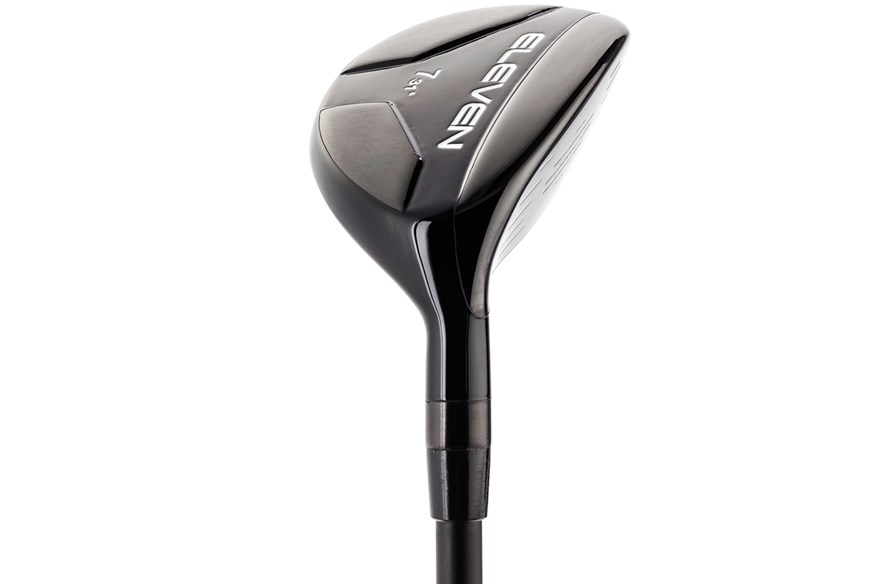

I say that because they’re so dam easy, not to just hit, but hit well. Eleven were winners for us in the High-Handicap Iron category in 2023 and did it again in 2024. Granted this model is not going to be for everyone. But if your game needs maximum help, and your swing speed is slipping away fast, our data highlights how they would be a brilliant choice.
Thanks to the hybrid body width our #7 Eleven sample produced masses of spin (13.5% more than our test average), shot height (11.1% more than our test average), and descent angle (6.5% steeper than our test average), exactly what slower speed players need to hit irons more effectively. The model was also bang on average for carry distance and generated a shot area 15.7% smaller than average which has to say this is a forgiving hybrid option geared to erratic golfers who spray shots all over the face.
For this price I’m really surprised Eleven hybrids now come with KBS TGI shafts as standard, a move our test pro thought upped stability and delivered more pop off the face than last year's model. If you don’t want a full set or just want to buy them individually, prices run to £89.99 each, which is incredibly good value in the current market.
Pros
- Back-to-back TG award winners.
- Easy to hit with solid all-round performance.
- KBS stock shafts as standard.
Cons
- The iron-hybrid concept won't be for everyone.
| Availability | 3-PW |
| Stock shafts | KBS TGI |
| 7-iron loft | 31° |
How the best 2025 High-Handicap Irons compare to competitor models
| Iron | 7-Iron Loft | Ball Speed | Launch Angle | Backspin | Height | Descent Angle | Carry Distance | Carry Distance Drop Off | Shot Area |
| Yonex Ezone Elite 4 | 125.6 MPH (3) | 13.9° | 4752 RPM | 28 YDS | 41.6° | 187 YDS (1) | 14 YDS | 219.8 SQ YDS | |
| Callaway Paradym AI Smoke HL | 30° | 127.4 MPH (1) | 14.8° | 5654 RPM | 32 YDS | 45.2° | 185 YDS (2) | 6 YDS (T1) | 103.8 SQ YDS (2) |
| Cleveland Halo XL Full Face | 29° | 123.9 MPH | 14.8° | 5079 RPM | 29 YDS | 42.2° | 184 YDS (3) | 13 YDS | 399.1 SQ YDS |
| Ram Wizard | 30° | 125.1 MPH | 14.4° | 5526 RPM | 29 YDS | 43.8° | 181 YDS | 6 YDS (T1) | 172.8 SQ YDS |
| Eleven | 31° | 127.2 MPH (T2) | 15.9° | 6454 RPM | 34 YDS | 47.4° | 180 YDS | 9 YDS | 169.2 SQ YDS |
| TaylorMade Stealth HD | 30° | 123 MPH | 15.8° | 5300 RPM | 30 YDS | 44.1° | 180 YDS | 7 YDS (T2) | 140 SQ YDS (3) |
| Cobra Air X | 31.5° | 123.6 MPH | 14.9° | 6053 RPM | 30 YDS | 44.8° | 176 YDS | 7 YDS (T2) | 53.2 SQ YDS (1) |
| PXG 0211 Z | 31° | 123.3 MPH | 15.5° | 6334 RPM | 31 YDS | 45.6° | 175 YDS | 15 YDS | 318 SQ YDS |
| Mizuno JPX923 Hot Metal HL | 31° | 122 MPH | 16.5° | 6025 RPM | 32 YDS | 45.7° | 175 YDS | 14 YDS | 231 SQ YDS |
| Average | 124.6 MPH | 15.2° | 5686 RPM | 30.6 YDS | 44.5° | 180.3 YDS | 10.1 YDS | 200.8 SQ YDS |
Best Golf Irons 2025: Buying Guide
Choosing a new set of irons is a decision not to be rushed. Do your research thoroughly and make sure you’re investing in the best golf irons to take your game to the next level. That’s critical for all clubs, but particularly as a new set of irons will likely be the biggest investment you make in your game.
Here are the key things you might want to prioritize when it comes to selecting the best golf irons to help you hit the dancefloor more often and make more birdies.
Types of iron
As mentioned in the introduction, there are five main categories of golf iron, each one designed to complement the swing characteristics of certain players:
Blades: Blade golf clubs have small, thin heads, designed to offer great looks, feel, and control. Blades typically have weak, traditional lofts (34° or even 35° for a 7-iron) and produce good spin rates but less distance than other types of golf iron. Don’t expect as much forgiveness or help with launch as you get from other golf irons. Blades are typically used by very good golfers, but it’s worth noting that even many of the world’s best golfers don’t play blades these days, preferring irons that offer a little more ‘help’ on less-than-perfect strikes.
Players’ irons: Players’ irons are typically aimed at low handicappers to elite golfers, with many tour pros choosing to use models from this category. They have many similar characteristics to blades (small heads, weak lofts, nice looks) but often have a little more technology packed in to boost distance and/or forgiveness slightly. If you strike your irons consistently well and don’t need much help with distance or forgiveness, our pick of the best players’ irons could be for you.
Players’ distance irons: A hugely popular category of iron, spearheaded by the TaylorMade P790, players’ distance irons pack a lot of distance and forgiveness into head shapes that still look great. The best players’ distance irons will typically create more speed and distance than blades or players’ irons, and while they may not generate quite as much spin, the high launch helps with stopping power on the greens.
Mid-handicap/game-improvement irons: These hugely versatile irons offer plenty of distance and forgiveness in a package that still looks and feels great. The very best mid-handicap irons are incredibly versatile and can be used by high-handicap golfers who are competent ball strikers down to very low handicappers who place greater value on extra forgiveness.
High-handicap/slow swing speed irons: These irons tend to be the most forgiving of all and also typically produce the most distance. Their bigger, chunky heads are packed with technology to make it as easy as possible for golfers of all abilities to get the ball airborne and heading in the right direction. They won’t win any awards purely on looks or feel, but if you struggle to hit irons well, the best high-handicap irons could really help you out.
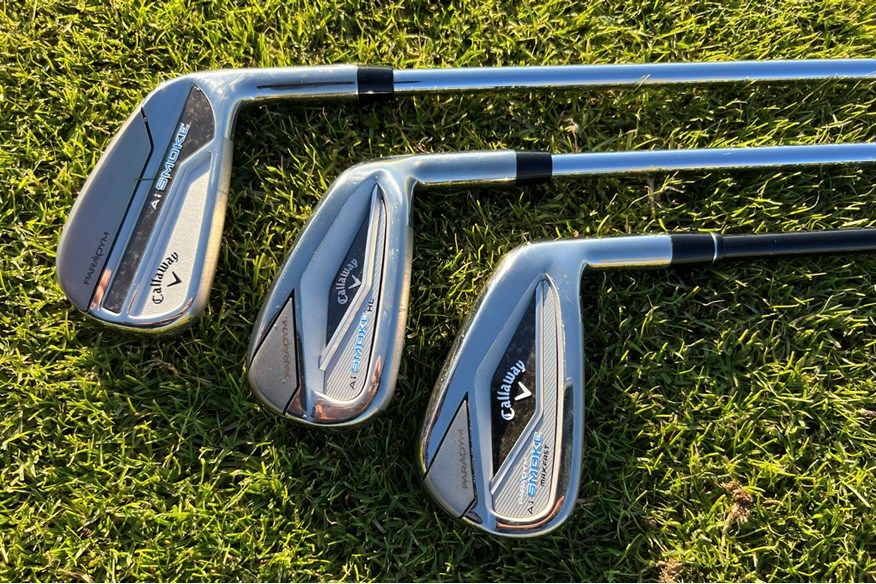
Type of construction
Golf irons are constructed by either casting or forging the raw metal alloy into a clubhead shape. The former involves pouring molten metal into a mold with forging consisting of hammering the metal into the desired shape. Fully cast or cavity back irons lend themselves to beginners and game improvers as the process allows for mass to be cast to the clubhead’s perimeter, boosting forgiveness. Fully forged clubs, such as blades, are best placed in the hands of better players, rewarding strikes from the centre of the face with enhanced workability and feel.
Increasingly, however, engineers are blending the two processes to combine the benefits of both forged and cast construction techniques, leading to the emergence of part-forged and muscle-back irons, allowing weight to be positioned favourably for forgiveness while keeping the control and feel advantages offered by the forged component.
Handicap and ability
Being true to yourself by aligning your playing standard with the type of iron best suited to your game is key to making the best purchase. While there is no rule preventing a high-handicap player from finding success with a blade iron for example, it’s probably unlikely for most golfers in this category. We suggest making your decision based on your ball-striking ability today and not where you want your game to be.
Loft
Not all irons are lofted equally with the typical 35° 7-iron loft now a thing of the past. The same club with one brand’s model may differ by close to 10° of loft, representing around two clubs’ difference. For slower-swinging players, manufacturers often release a HL (high-launch) version of their latest model to promote steeper landing angles and more stopping power. Faster players can naturally achieve the same results from increased spin generation. You can learn more about whether stronger lofted irons are best suited to your game in our video below.
Custom fitting
It is often overlooked, but dialling in your optimal set-up through a custom fitting session will likely be of more benefit than the slight performance edge you hope to achieve by selecting one set of irons over another. If you’re not sure where to start, we suggest nipping down to your club Pro, or nearest golf retailer to explore the shaft, flex, lie angle, and a whole host of other variables that will help you extract the most value from your chosen model.
Budget
As with most things in the golf world, prices for irons can vary considerably. Value for money is subjective and therefore you should spend however much you feel comfortable with, be it a premium set, or one with a more competitive price point.
If you’re ready to upgrade in 2025 but can’t justify the dizzying price tags of the games’s powerhouse brands, check out our pick of the best golf irons from 2023. Many of these recently replaced models are now available at reduced prices and still deliver a modern and competitive performance package.
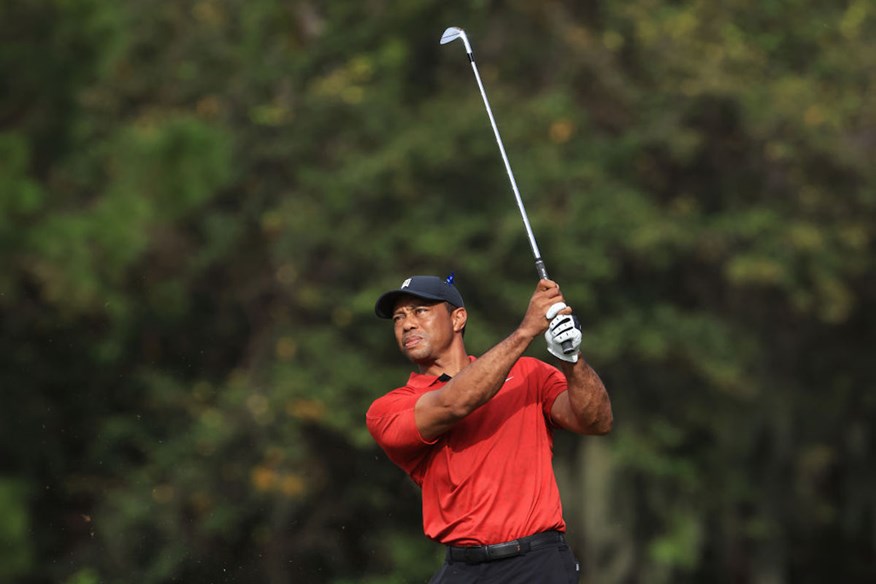
Best Golf Irons 2025: FAQs
What are the best golf irons to use?
The best golf irons to use will be highly dependent on many things including ball striking ability, handicap level, and the value each golfer places on particular performance characteristics such as distance, forgiveness, or feel. To help find the best golf irons for you, Today’s Golfer suggests narrowing down your options by reading our best golf irons pages and then booking a custom fitting session to help optimize their performance for your swing.
What is the easiest type of iron to hit in golf?
For the vast majority of golfers, deep cavity back irons aimed at the mid-to-high handicap market will be significantly easier to hit than blade irons or players’ irons. The confidence-inspiring head size and technology on offer make these clubs as easy as possible to get airborne and sailing towards the green. These models are often referred to as ‘super game improvement’ irons and are among the most forgiving available and perfect for beginners and high-handicappers.
What are the best game improvement irons?
The best game improvement irons are typically aimed at mid-handicap players seeking a good blend of distance and forgiveness, but in a package that has the look and feel of a premium quality iron. With the average handicap sitting somewhere in the mid-teens, it’s little surprise that mid-handicap irons are incredibly popular. It’s an area most brands have focused on over the last few years, meaning there’s a fantastic range of mid-handicap irons to choose from.
What irons do Tiger Woods and Rory McIlroy use?
Both Tiger and Rory game TaylorMade irons. Tiger uses TaylorMade P7TW irons (4-PW) with True Temper Dynamic Golf Tour Issue X100 shafts, whereas Rory opts for the brands’ P760 4-iron and P730 Rors Proto irons (5-9) with Project X Rifle 7.0 shafts. Bear in mind, however, that these are two of the best ball strikers of all time, and you should consider which TaylorMade iron is best for you before splashing the cash on your idol’s exact model.
SUBSCRIBE TO TODAY’S GOLFER: Print and Digital access, discounts and rewards!
